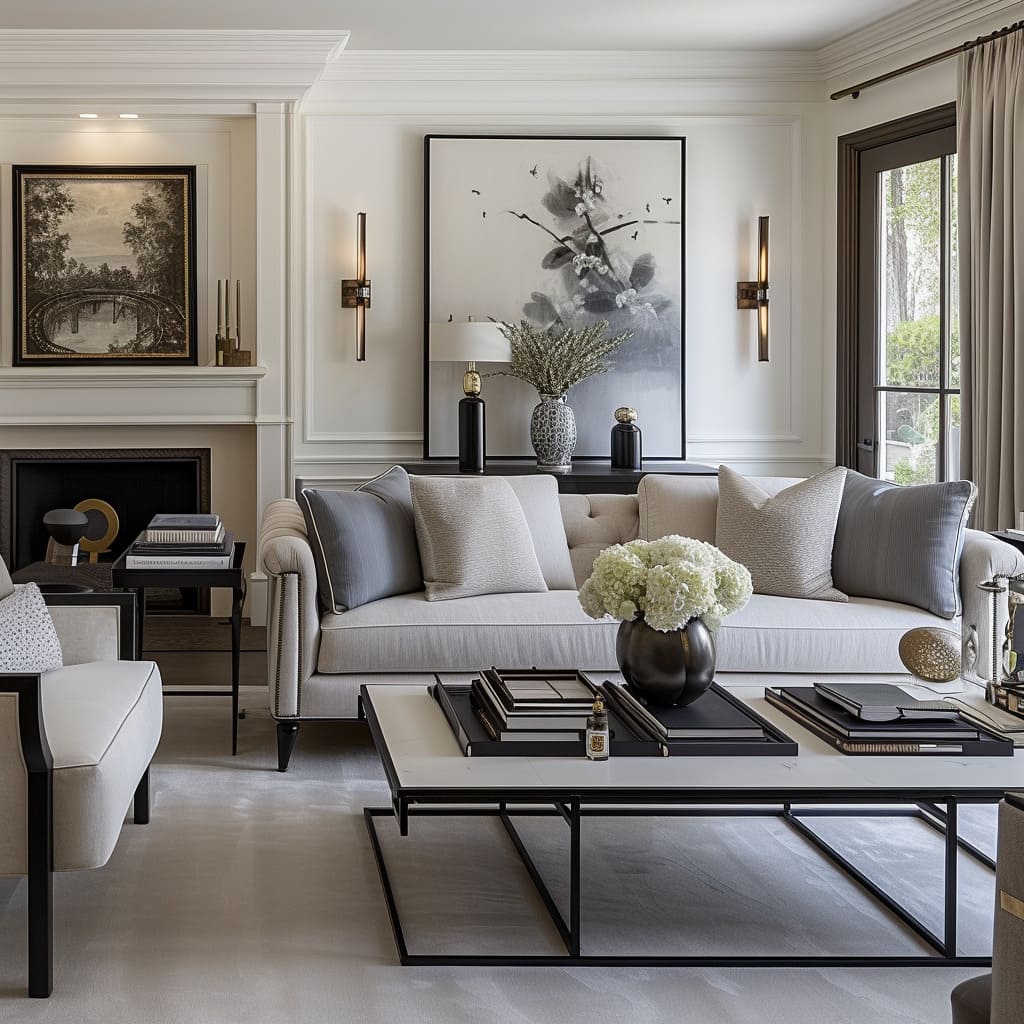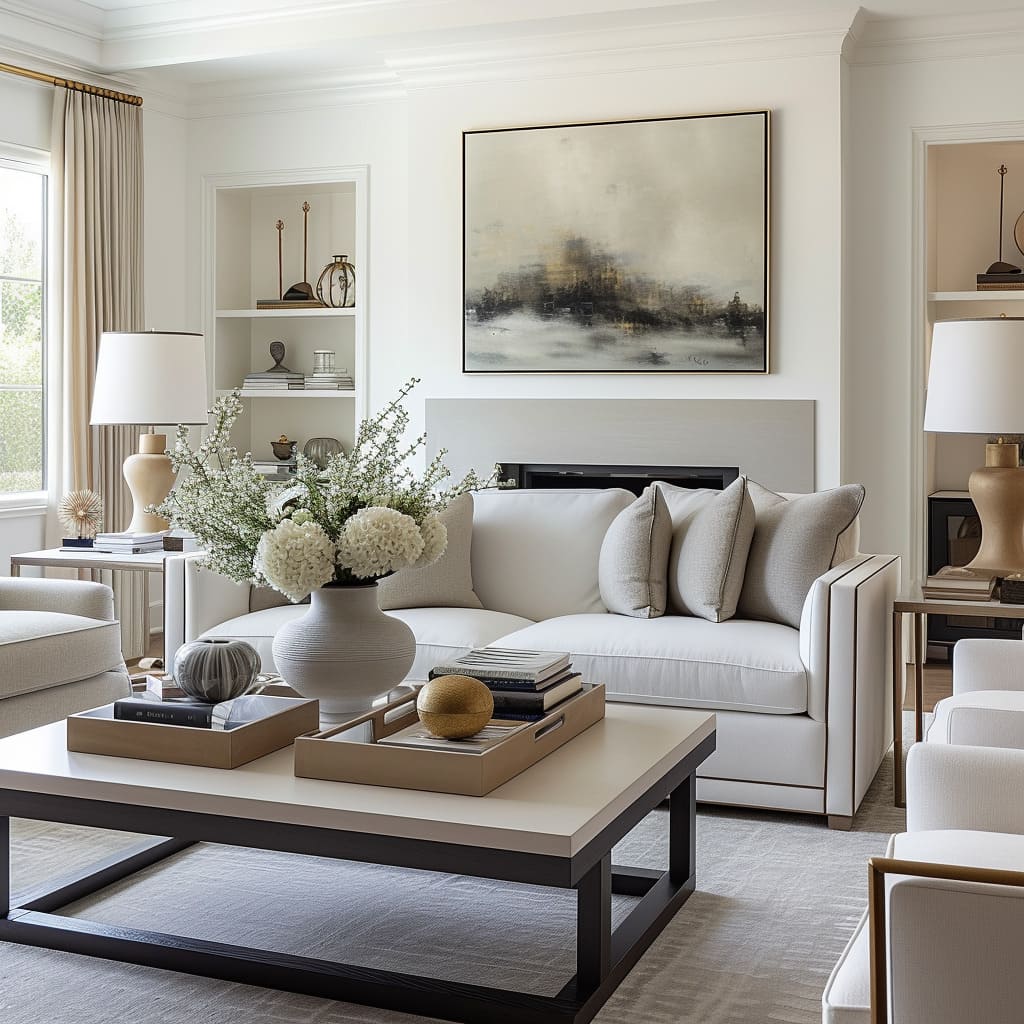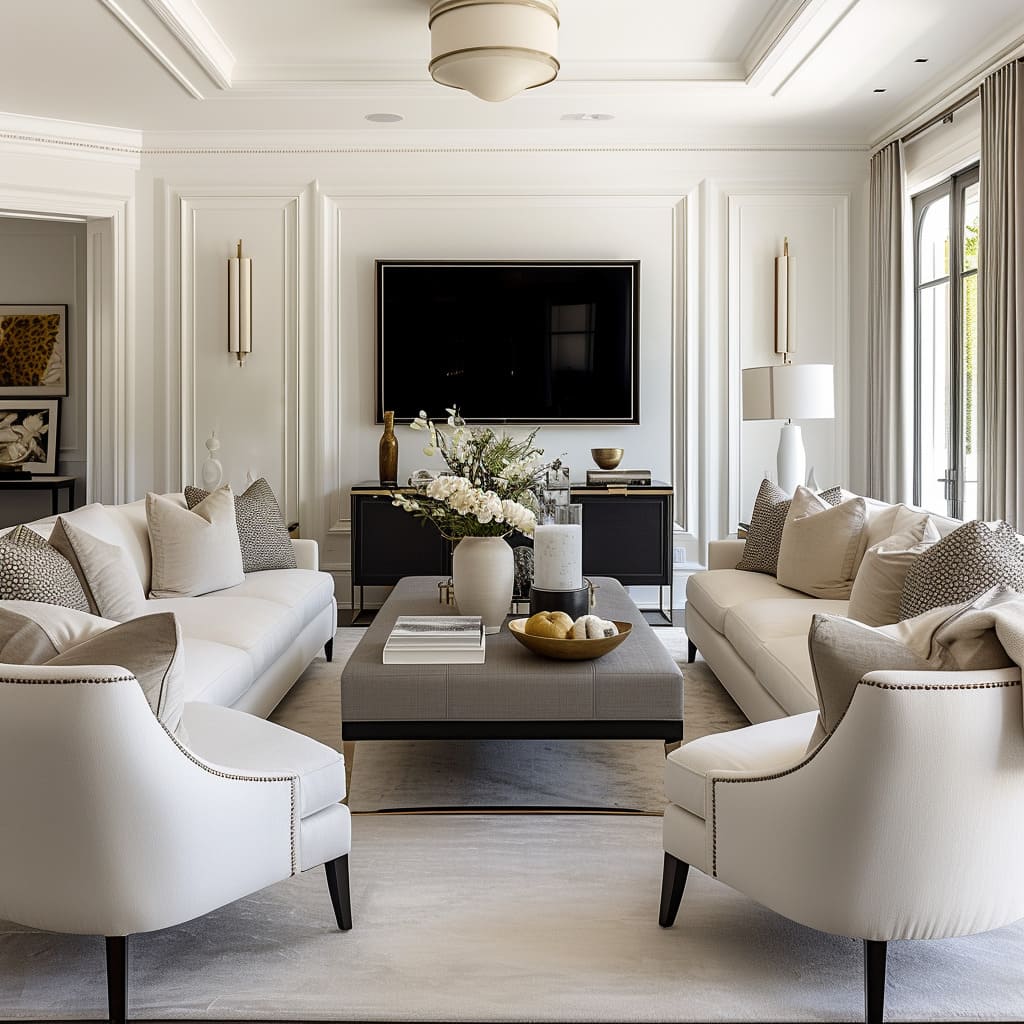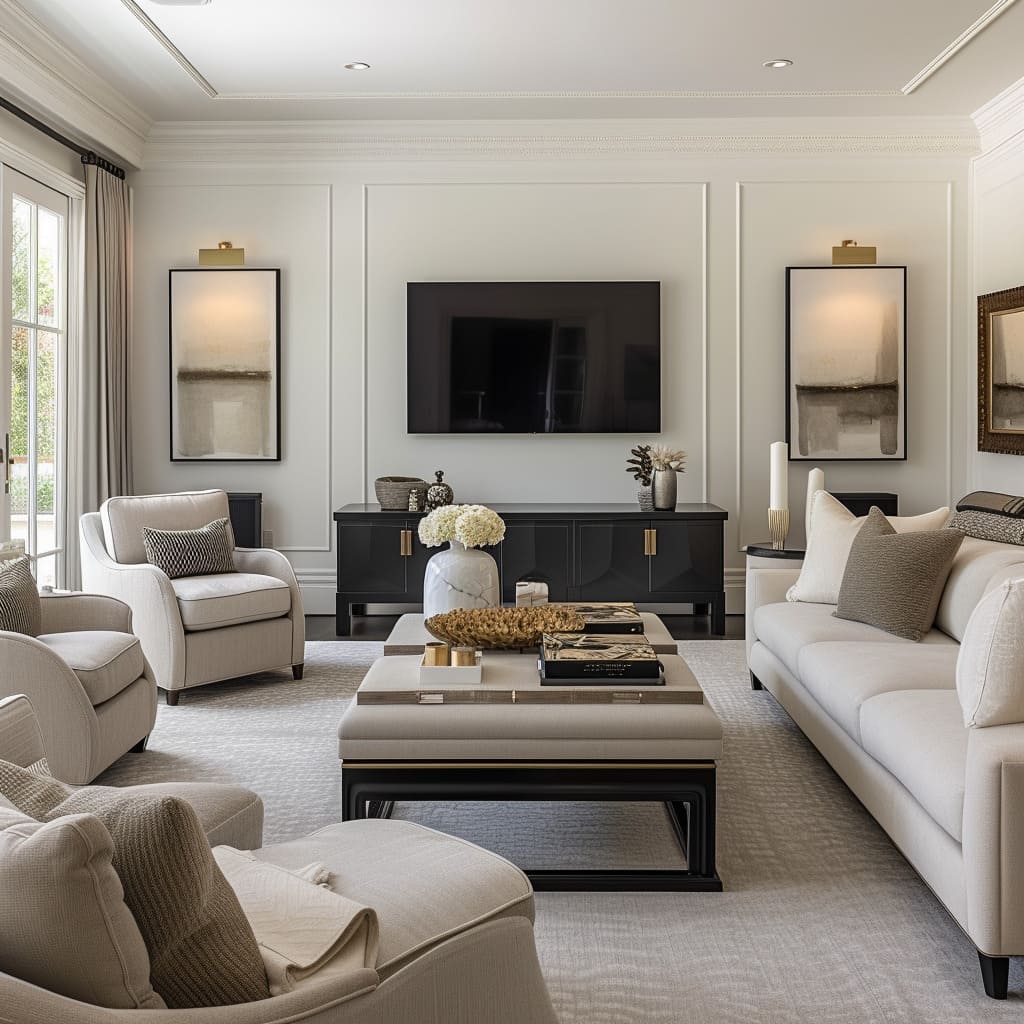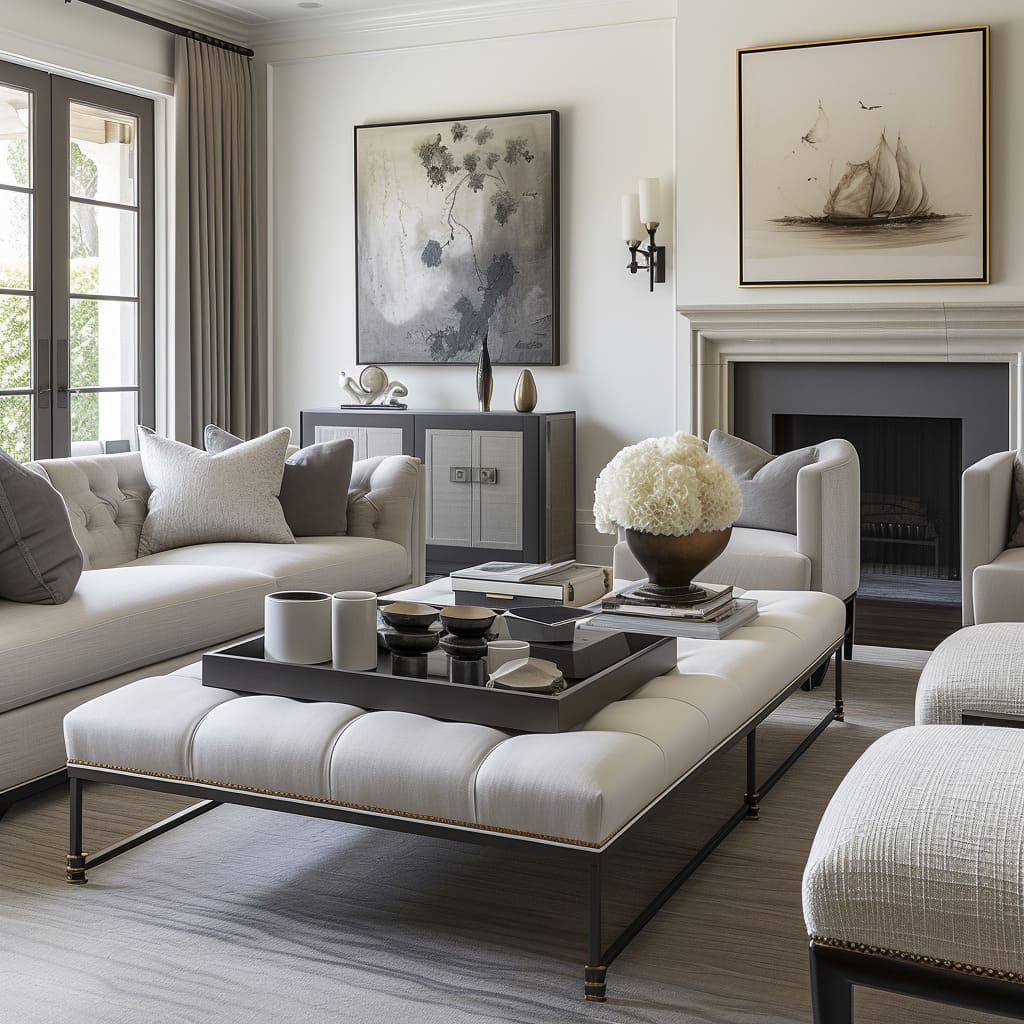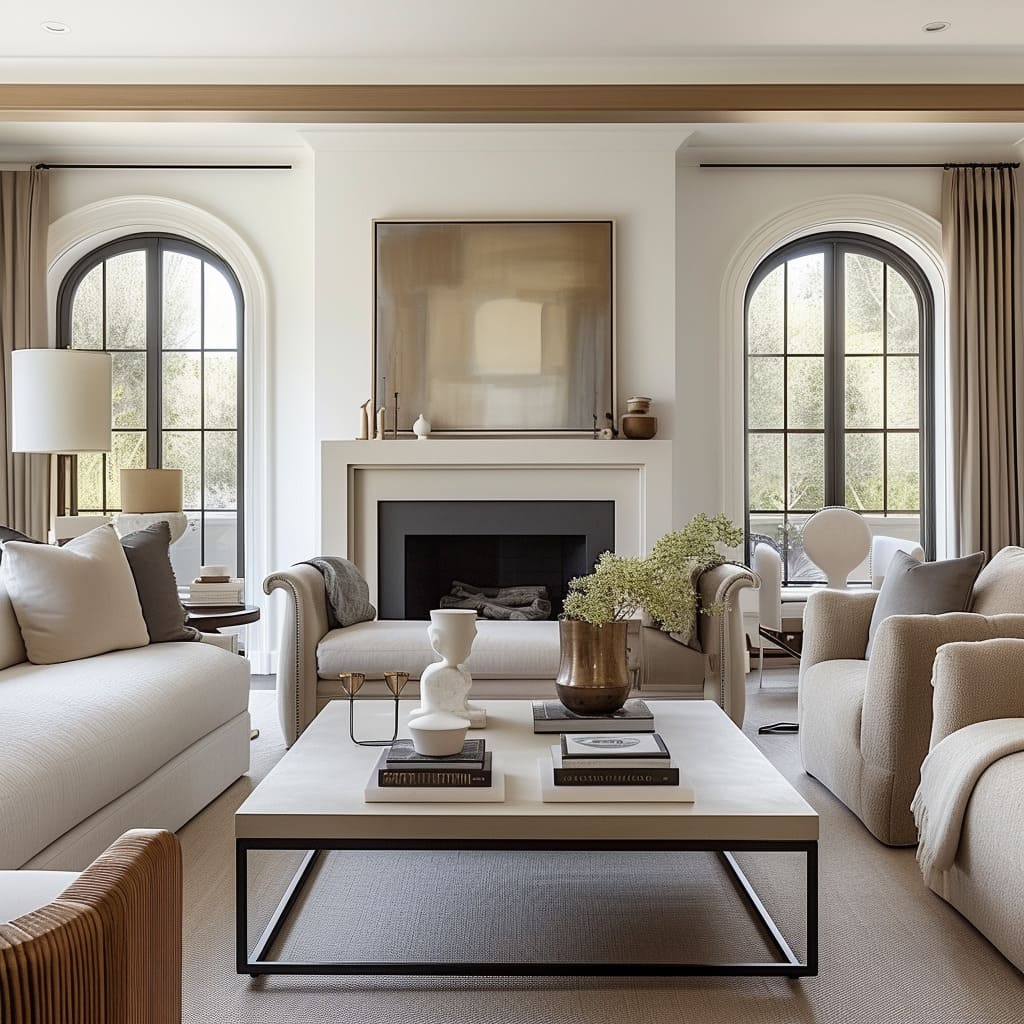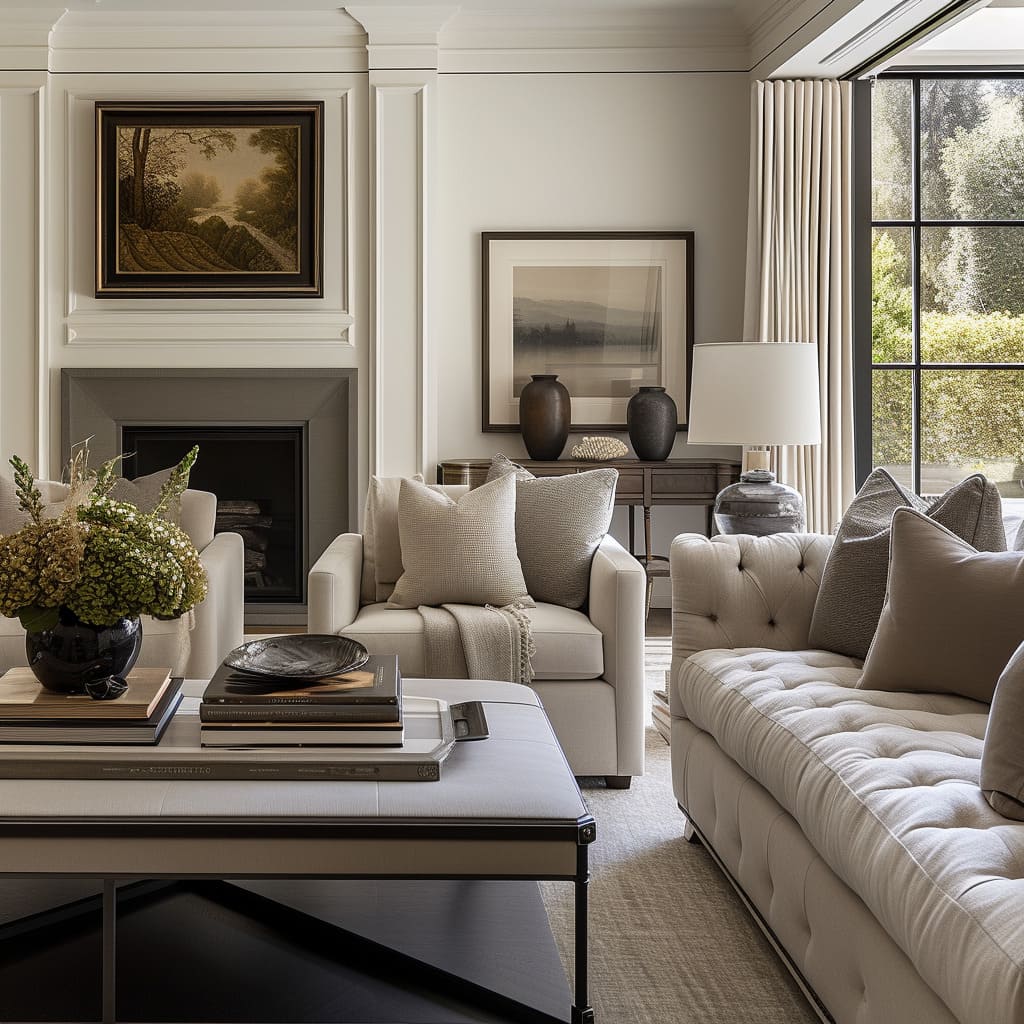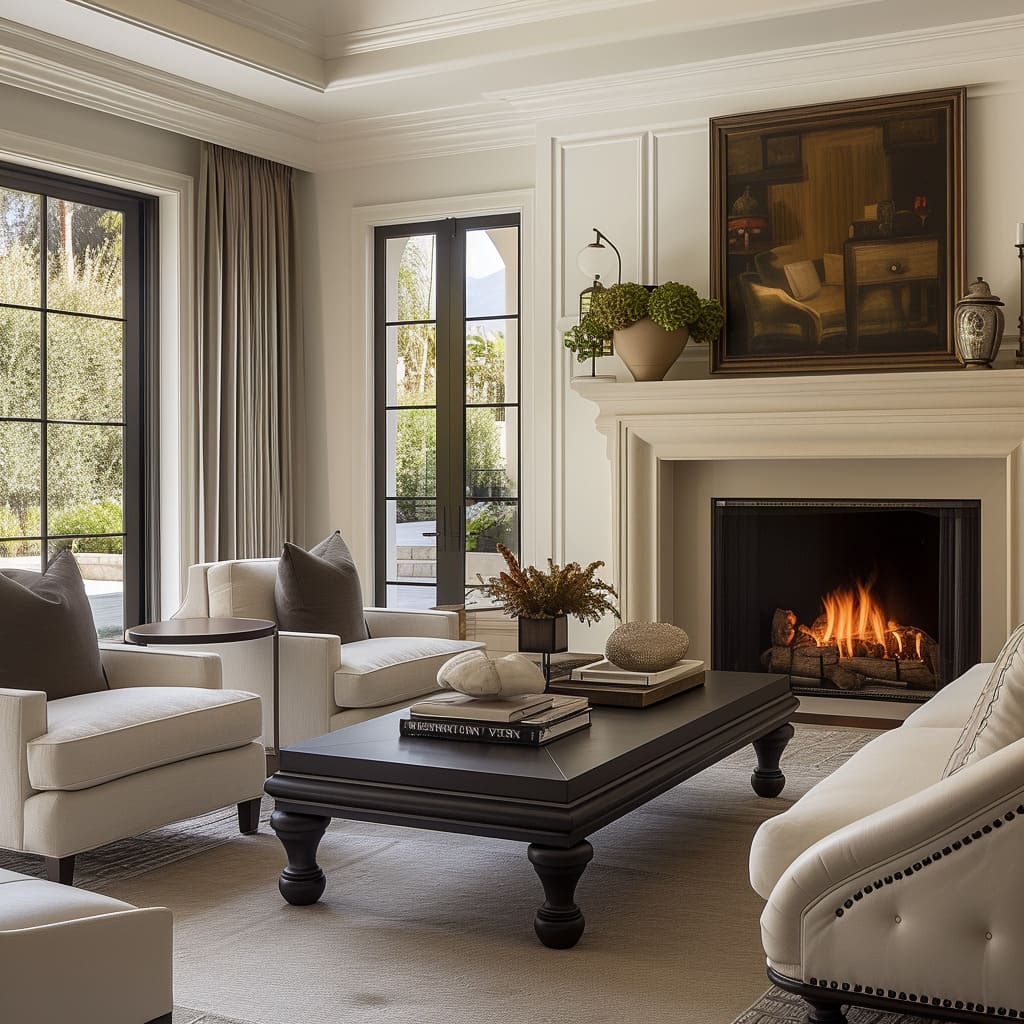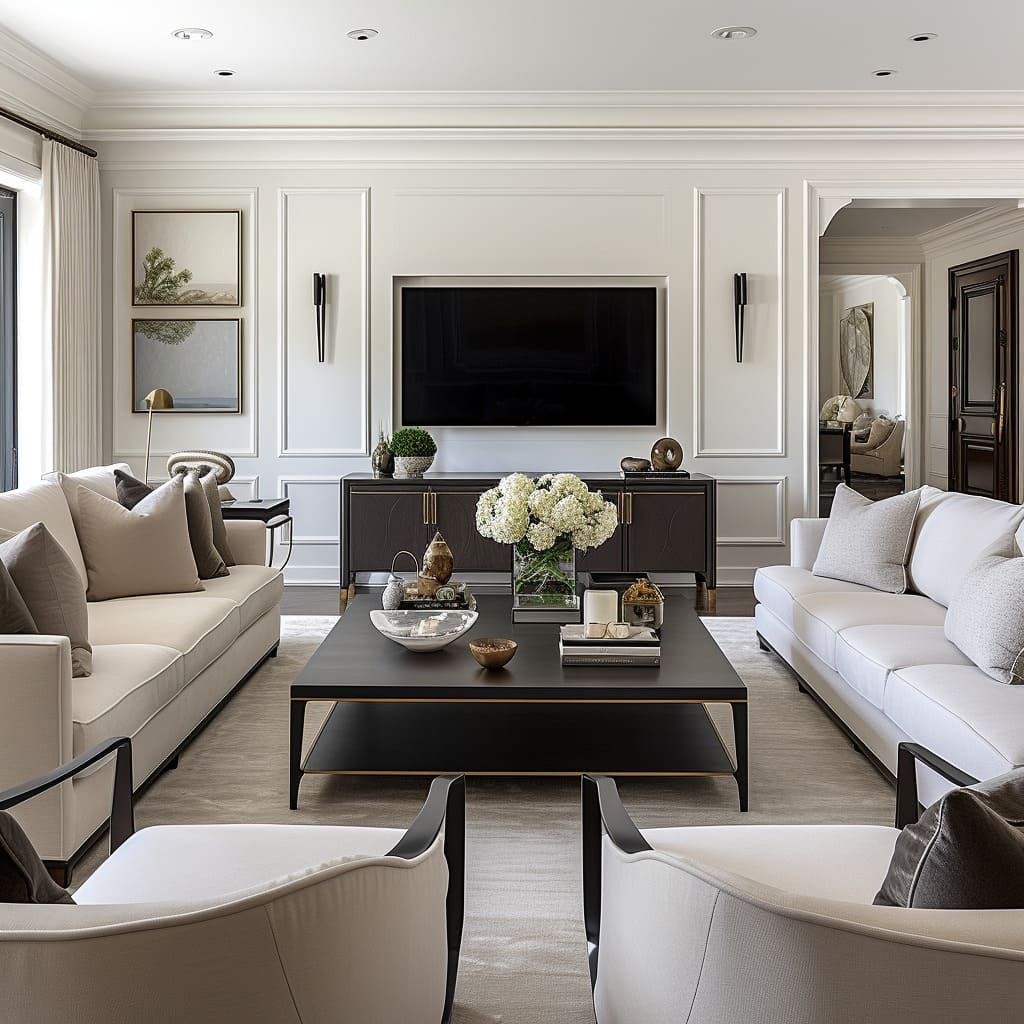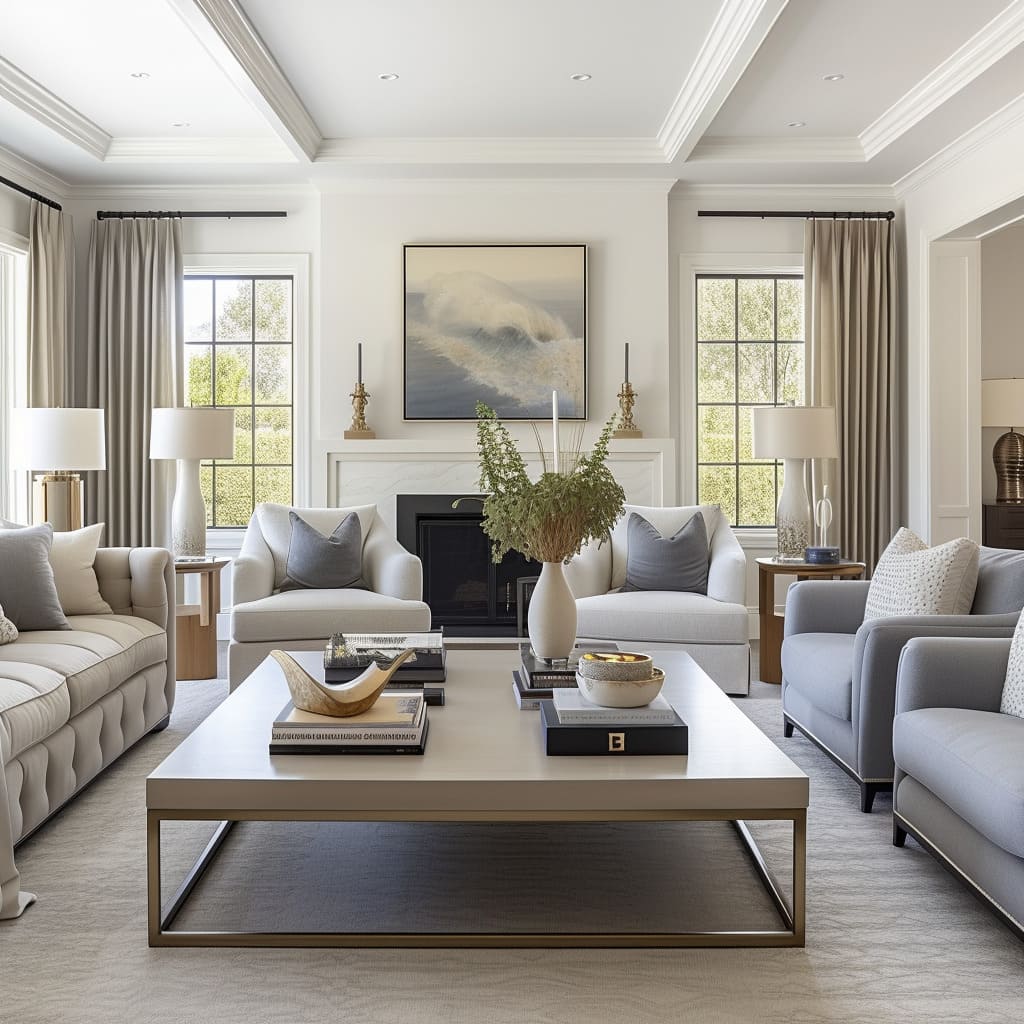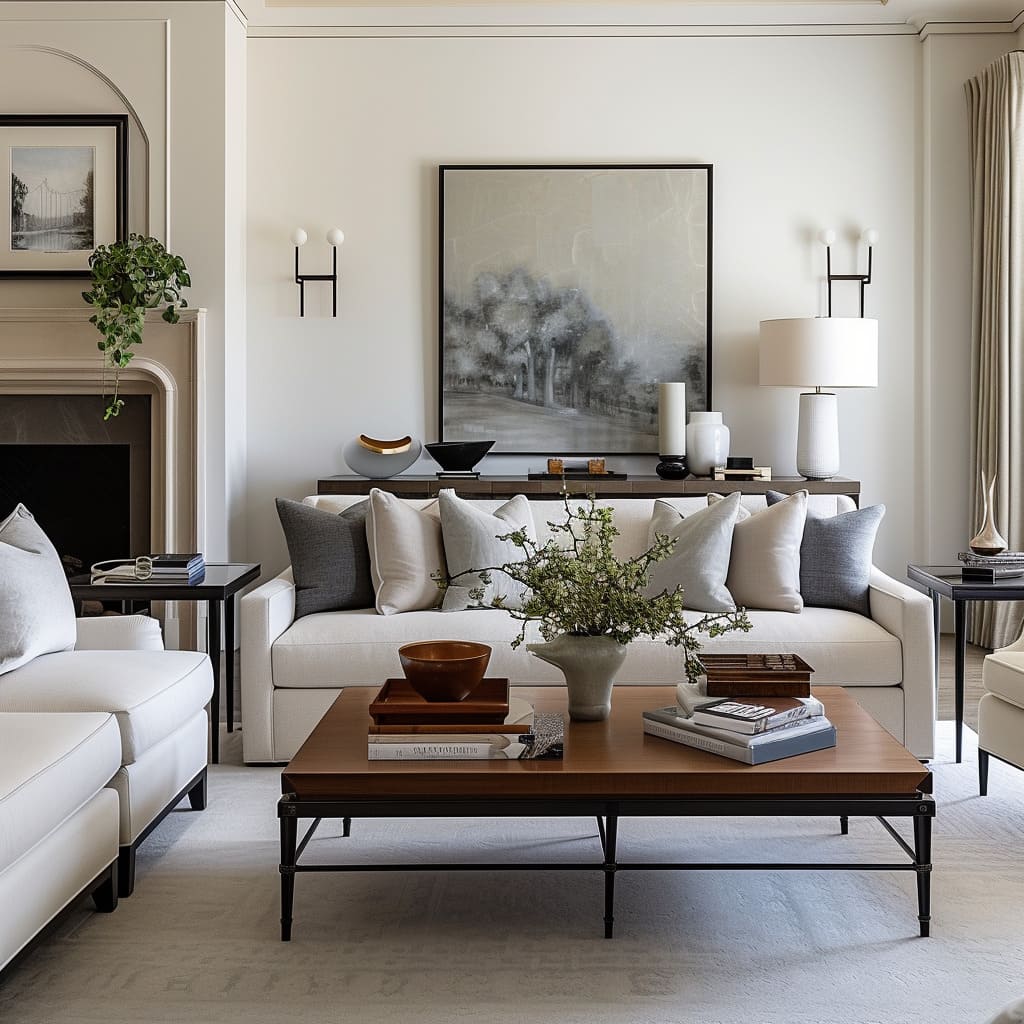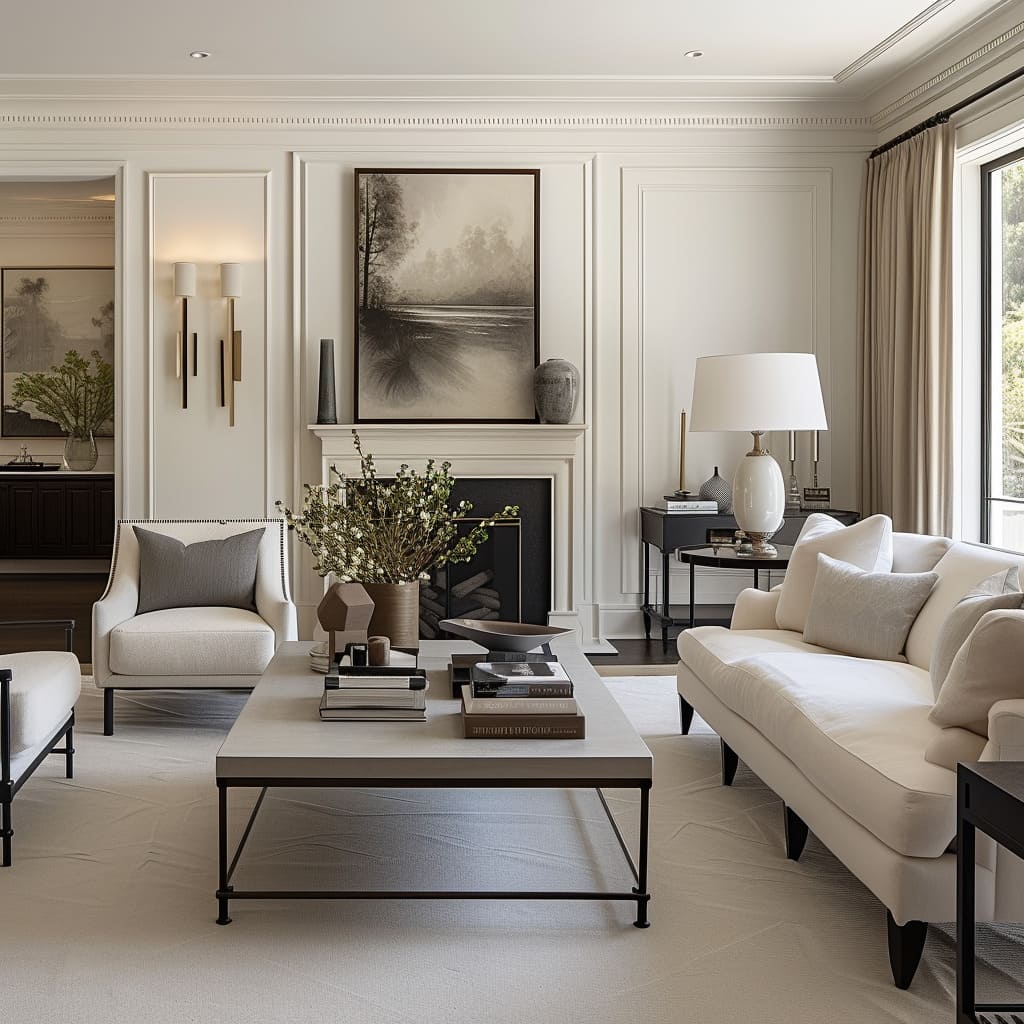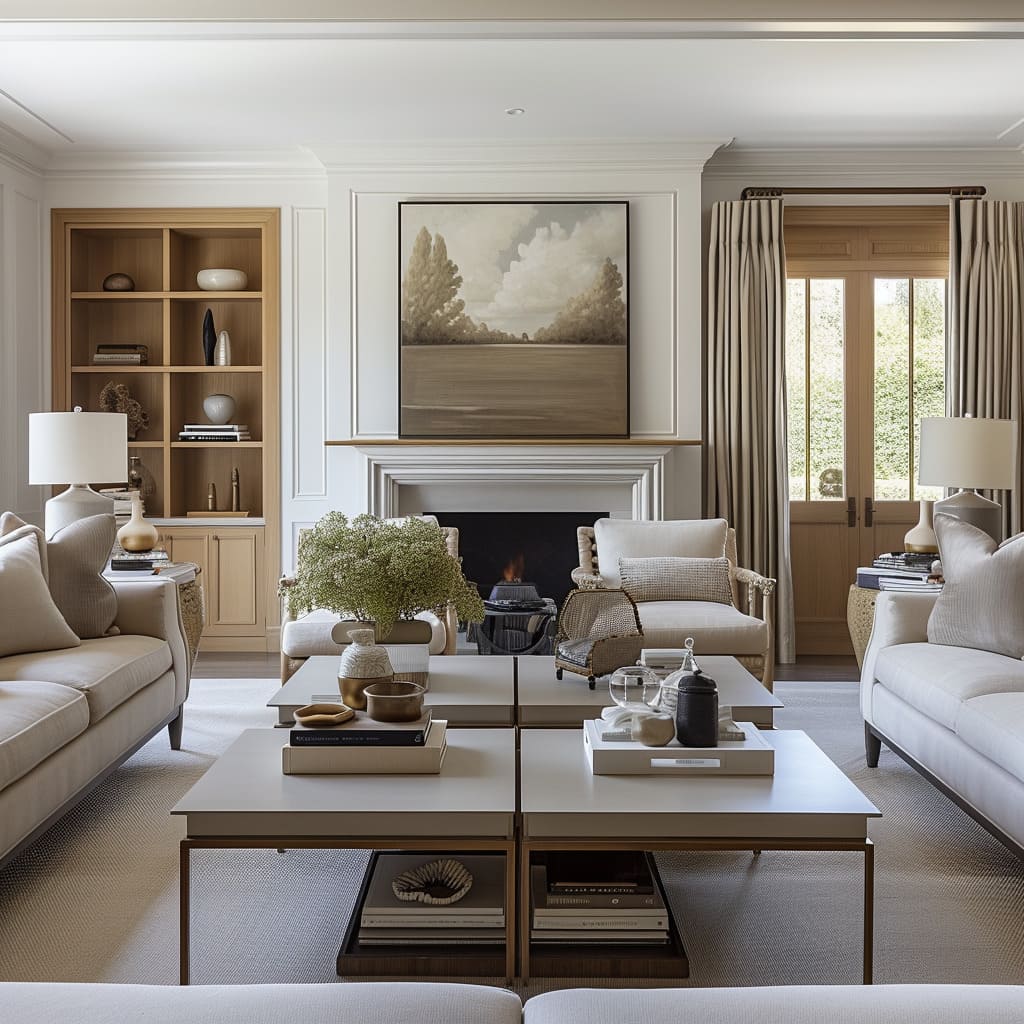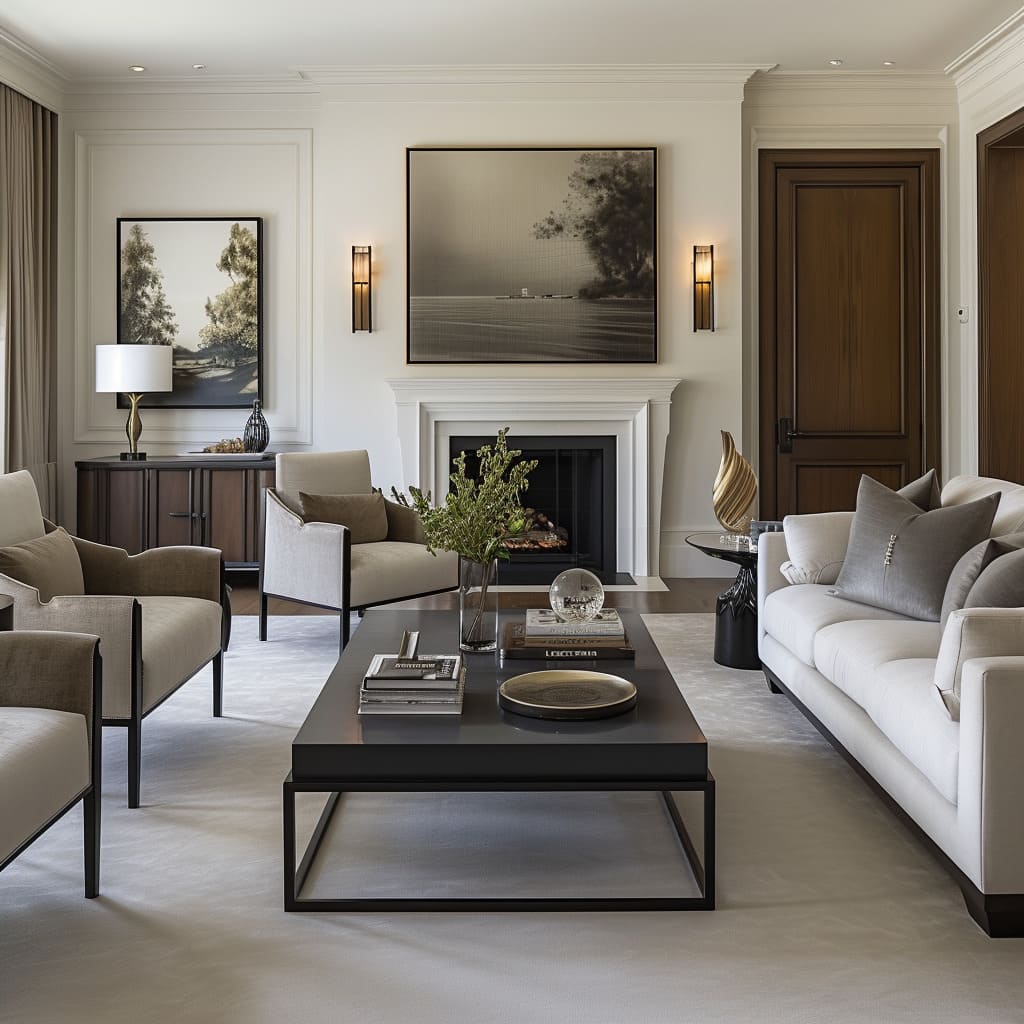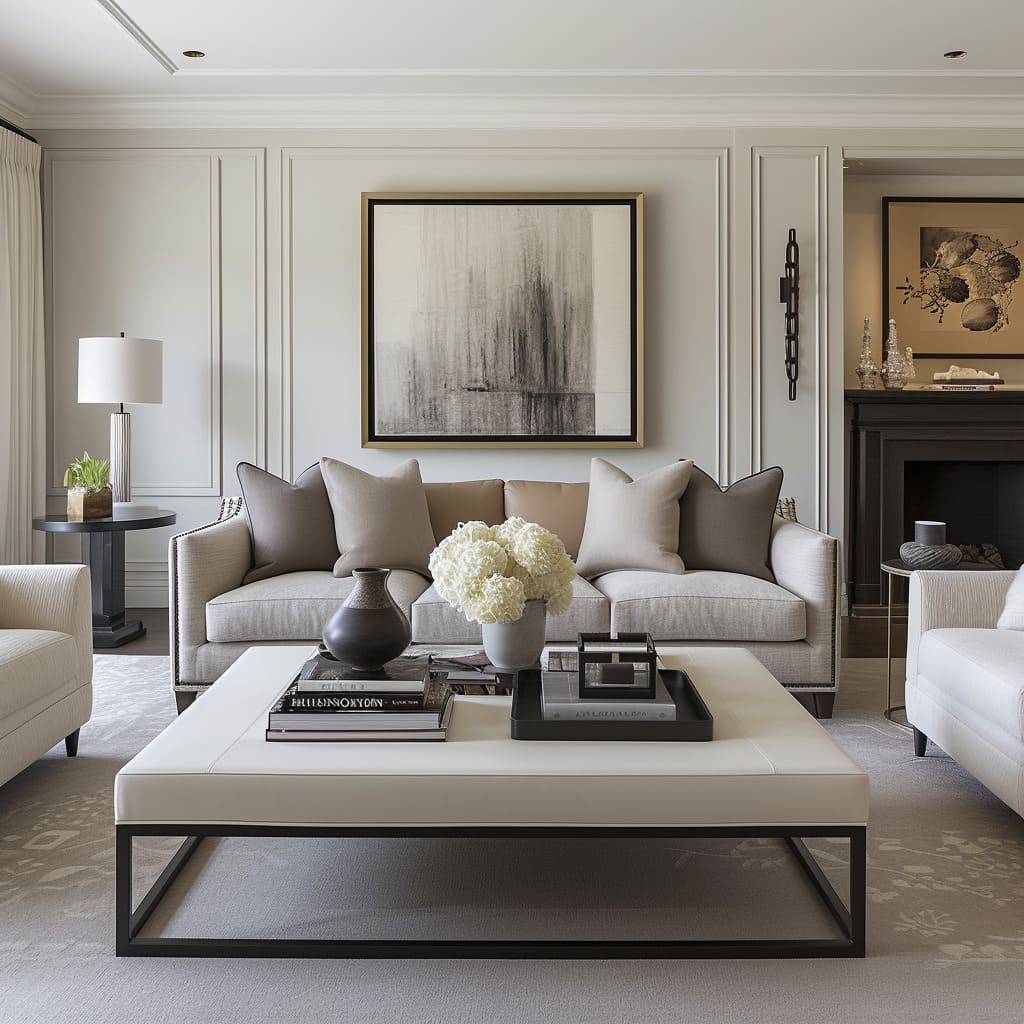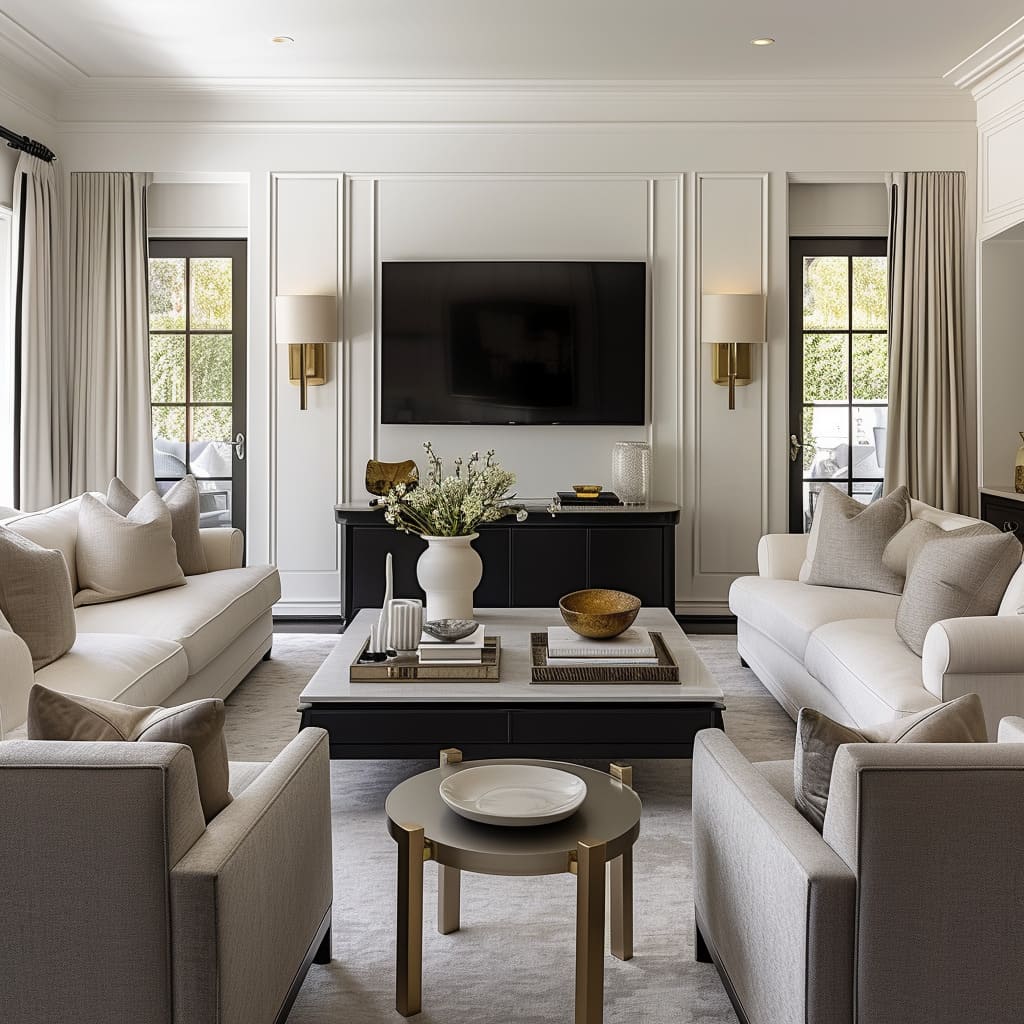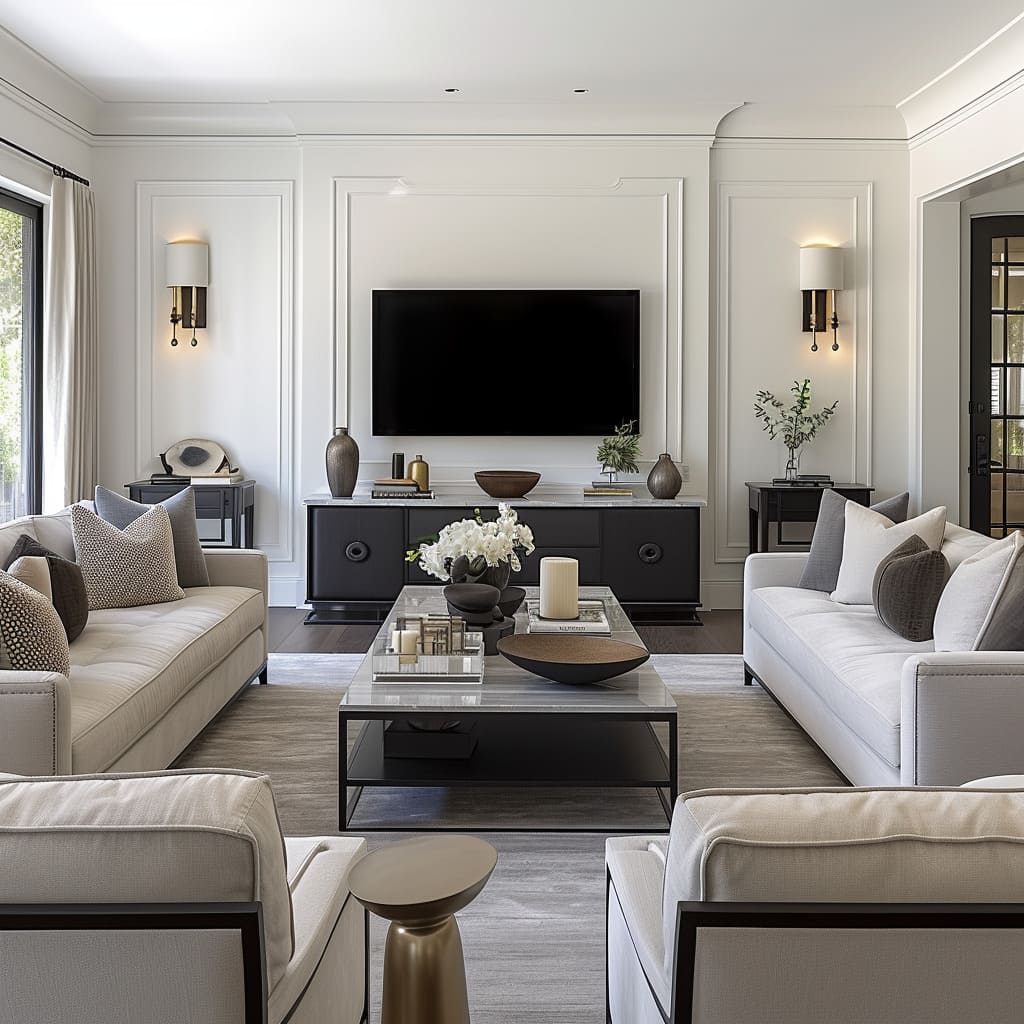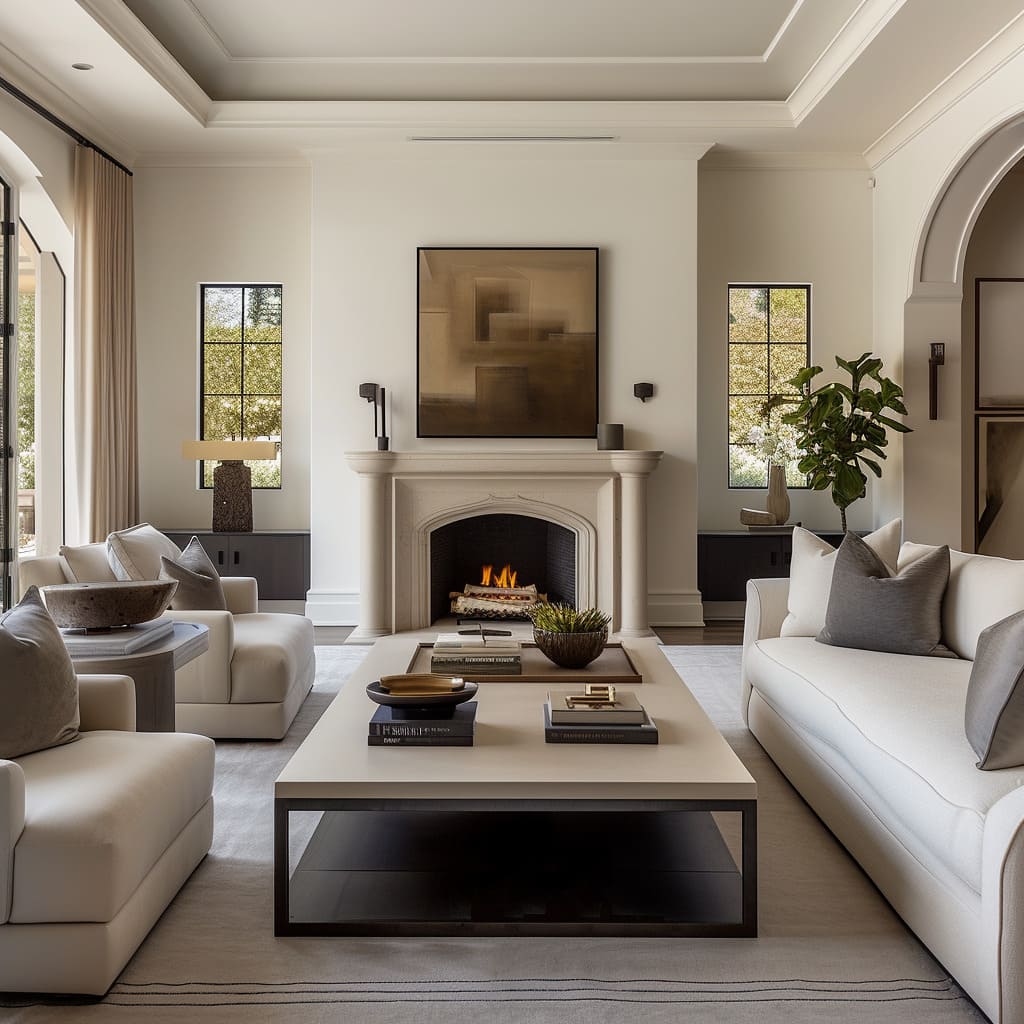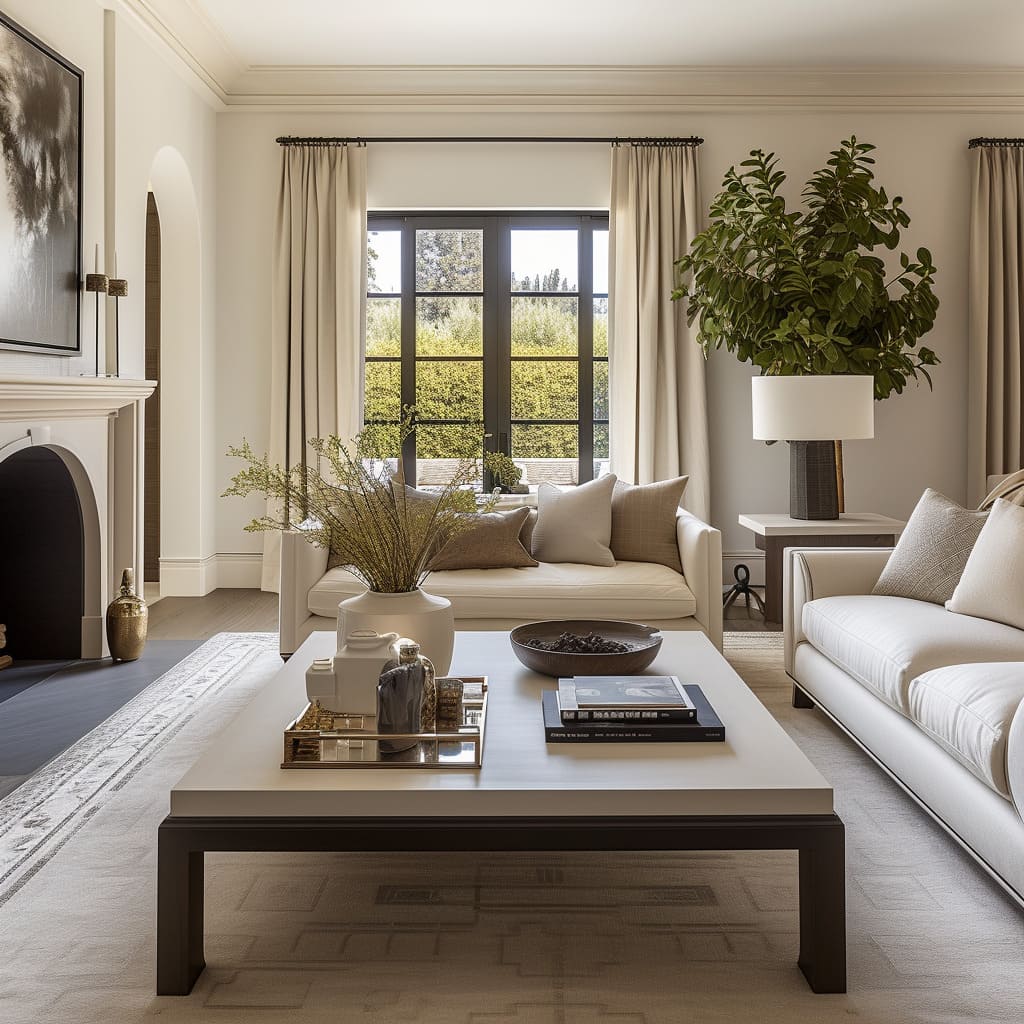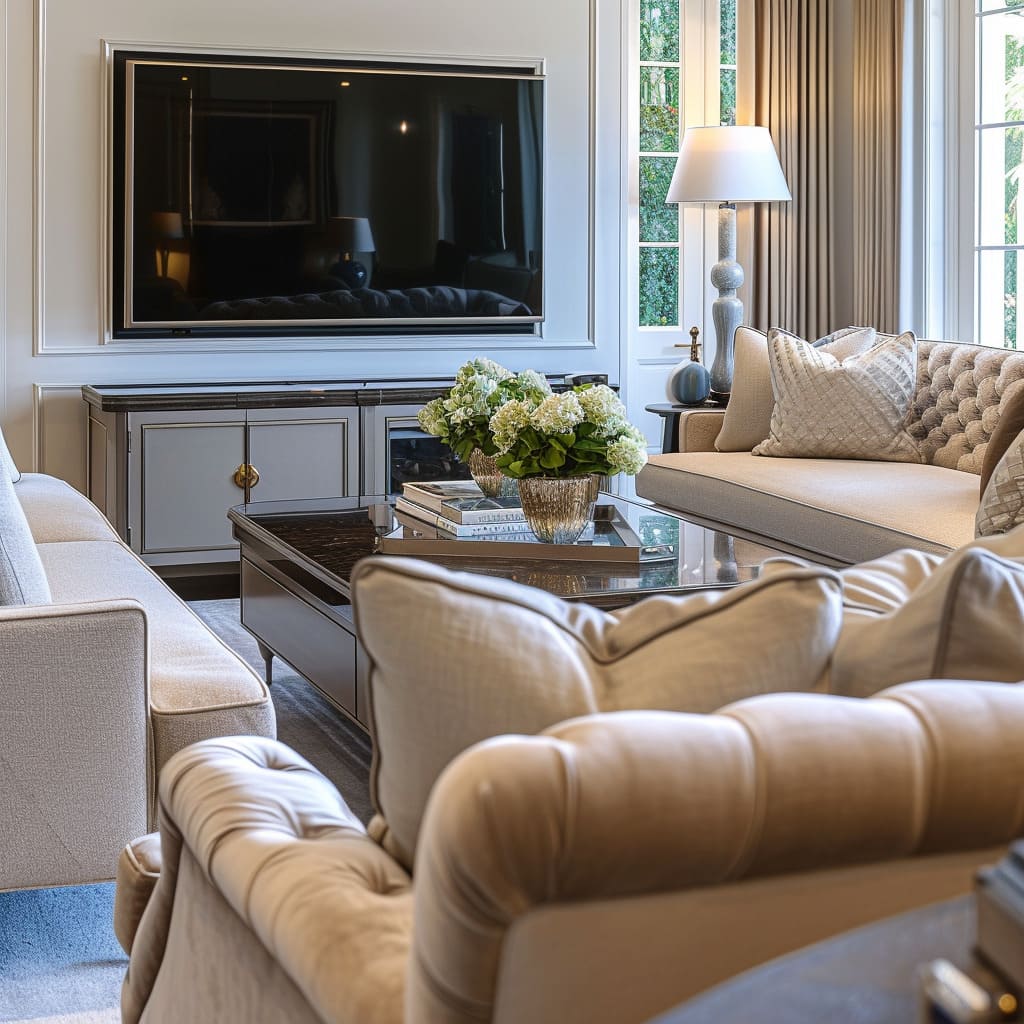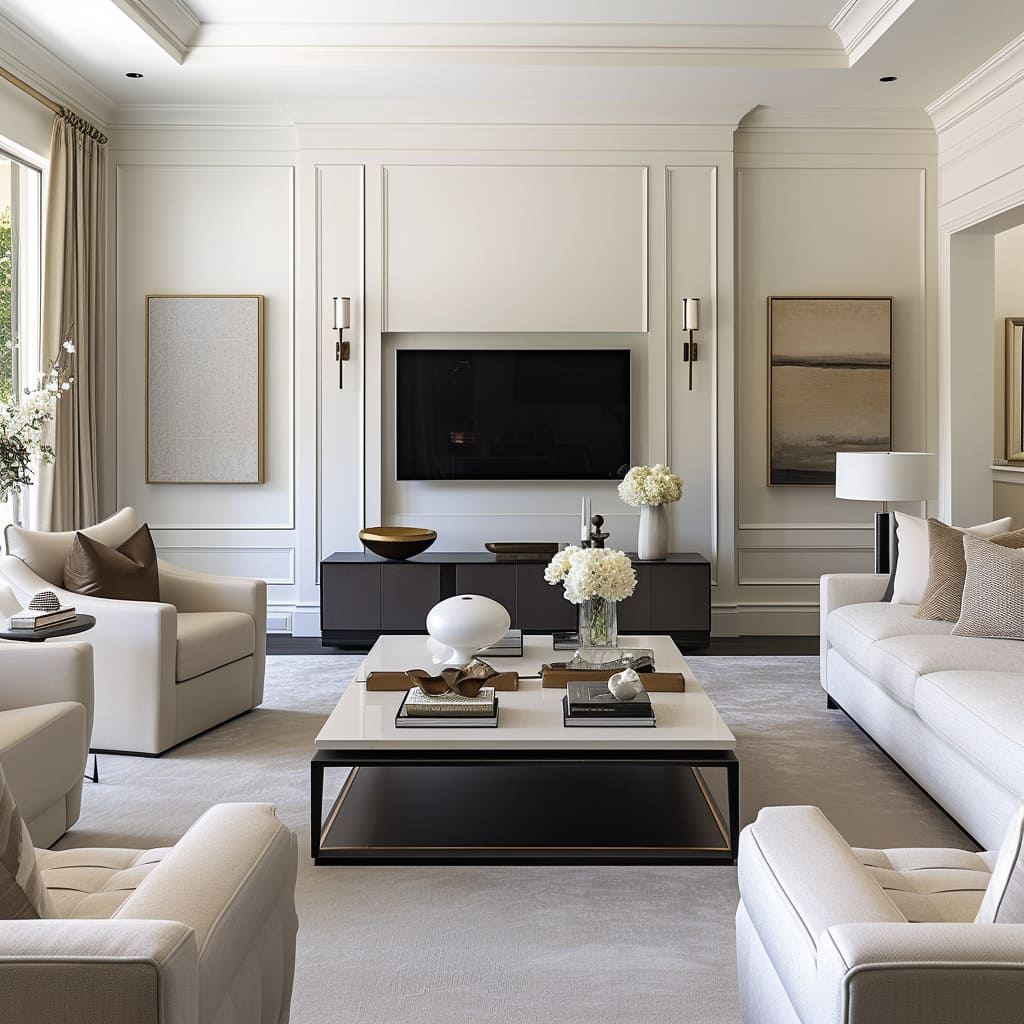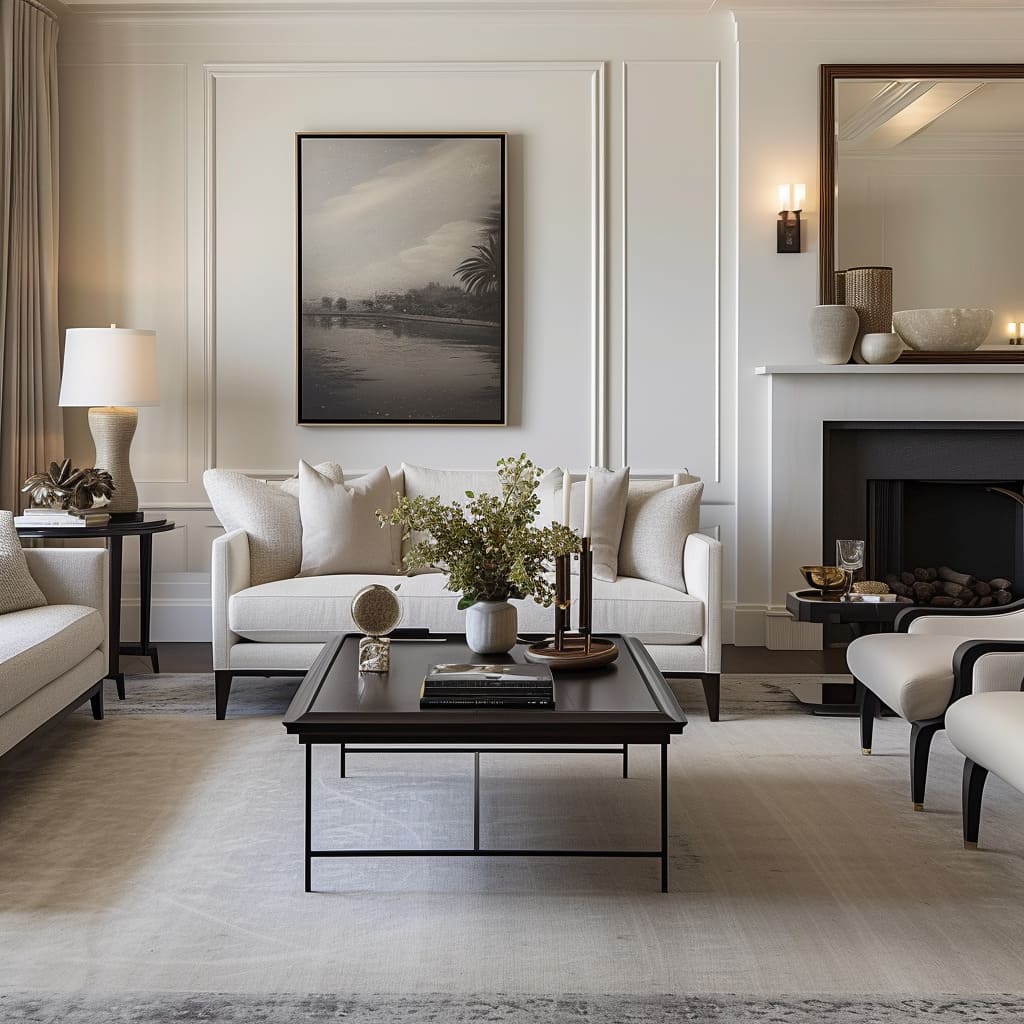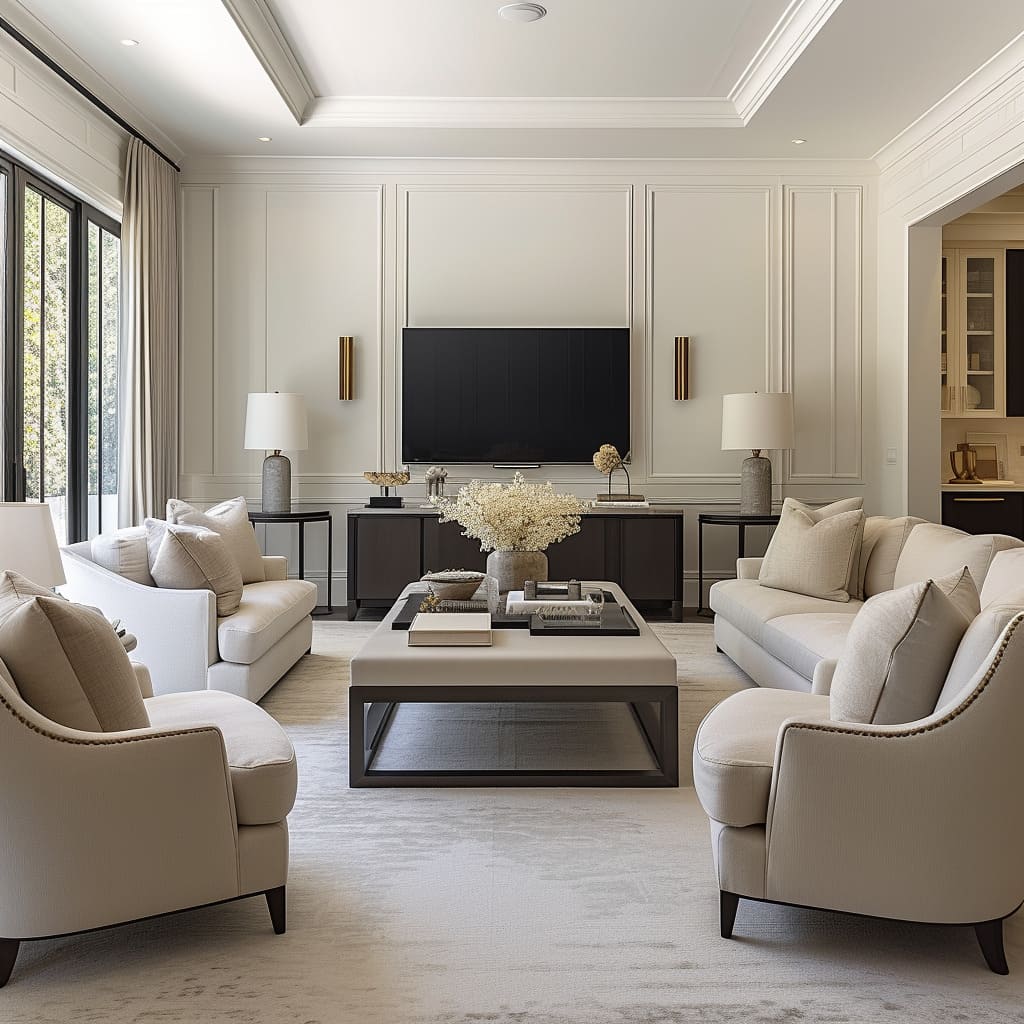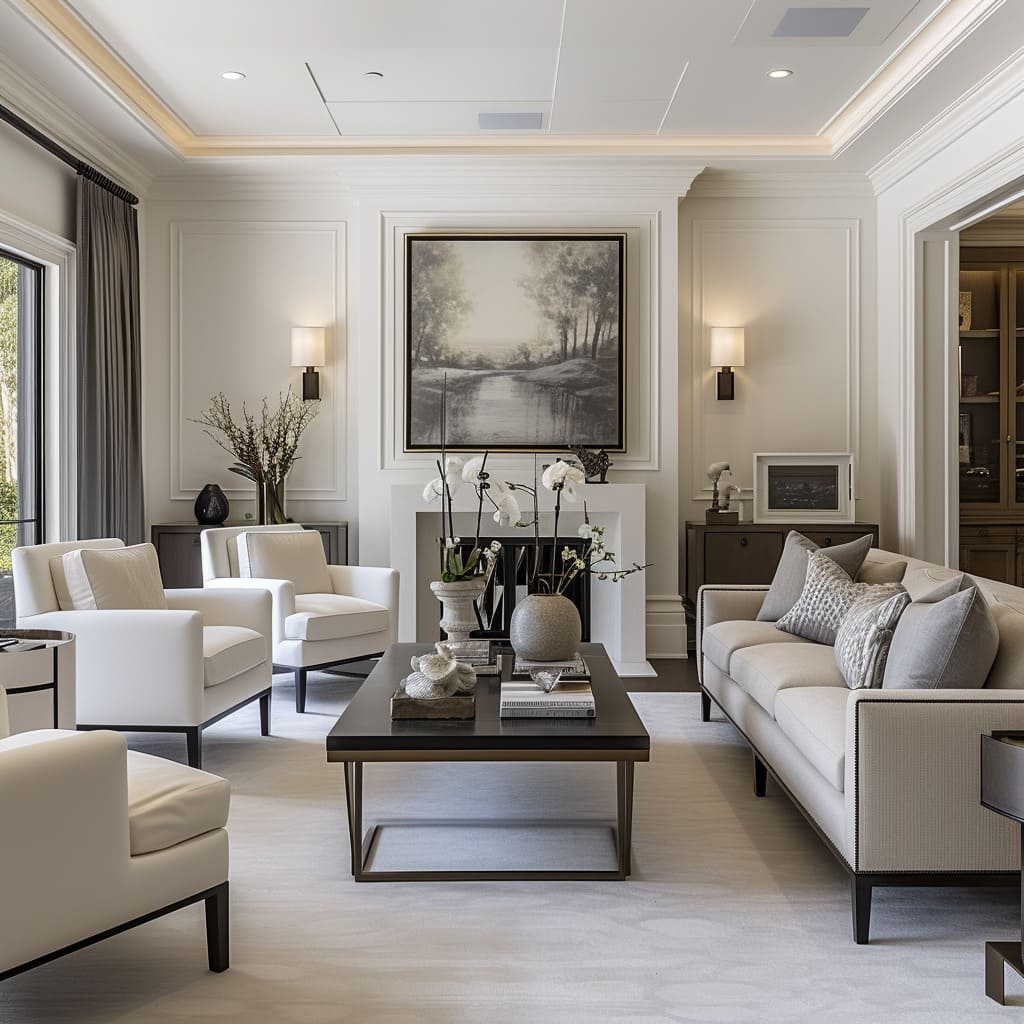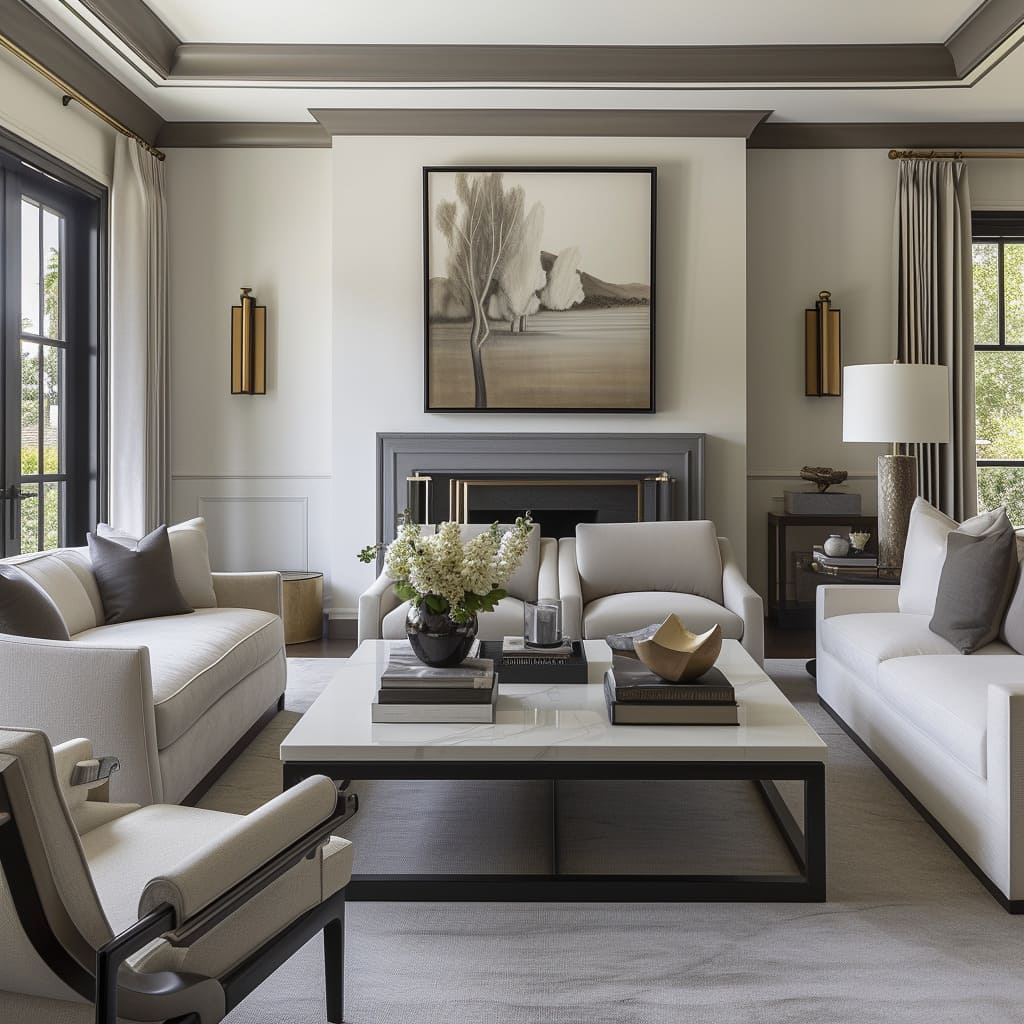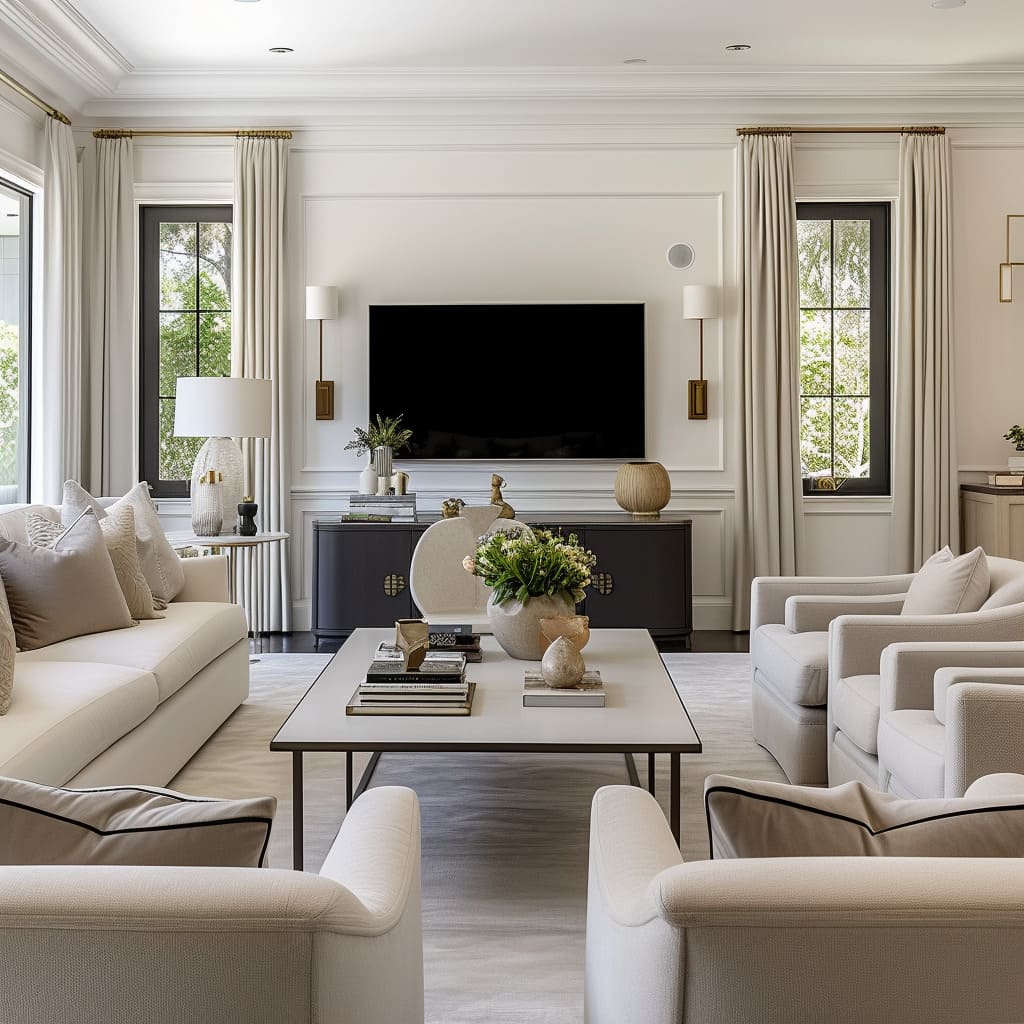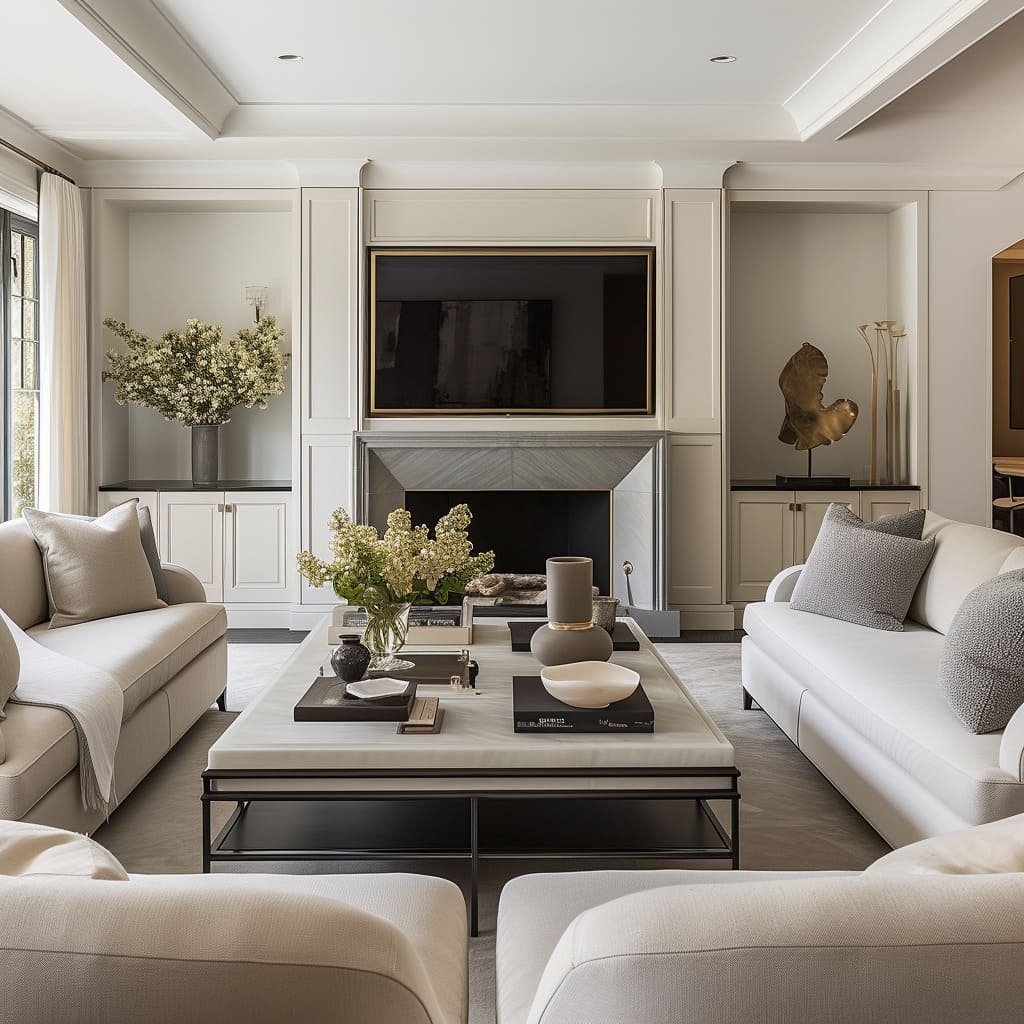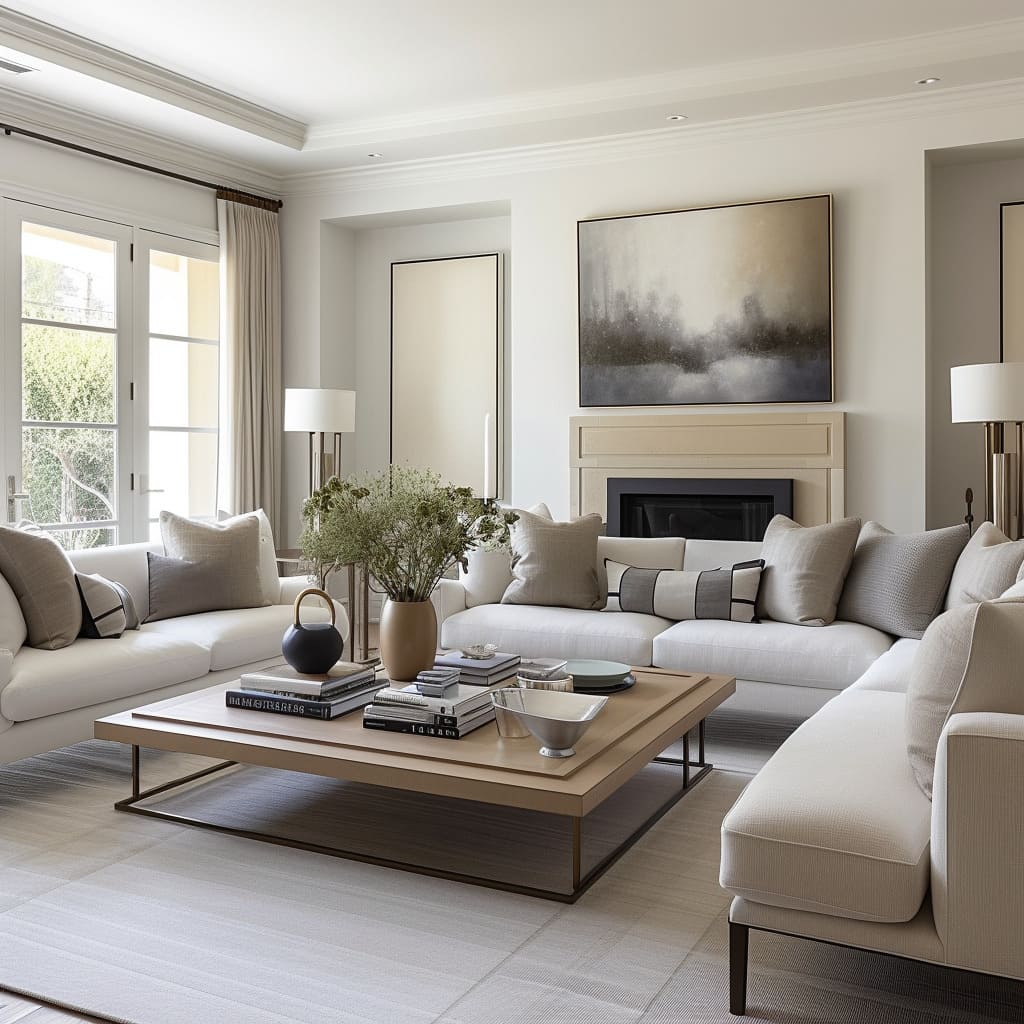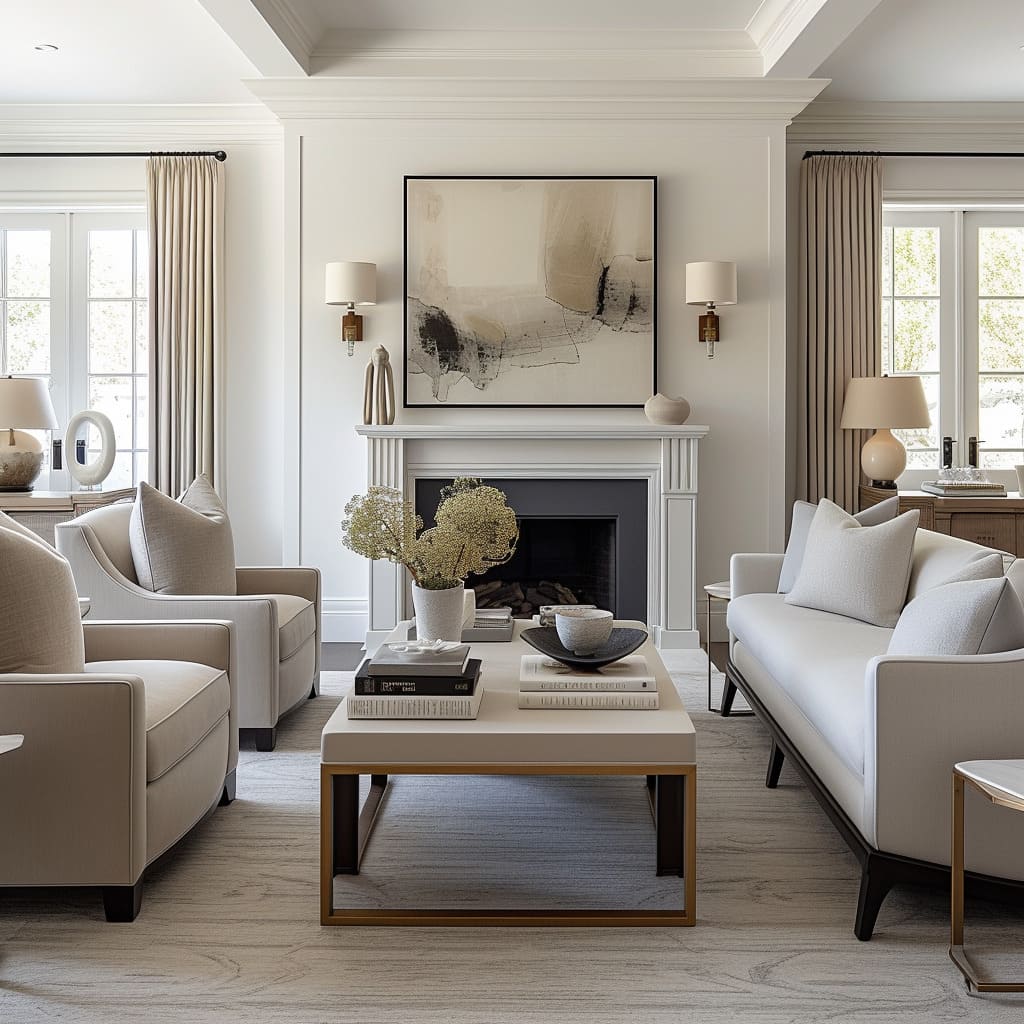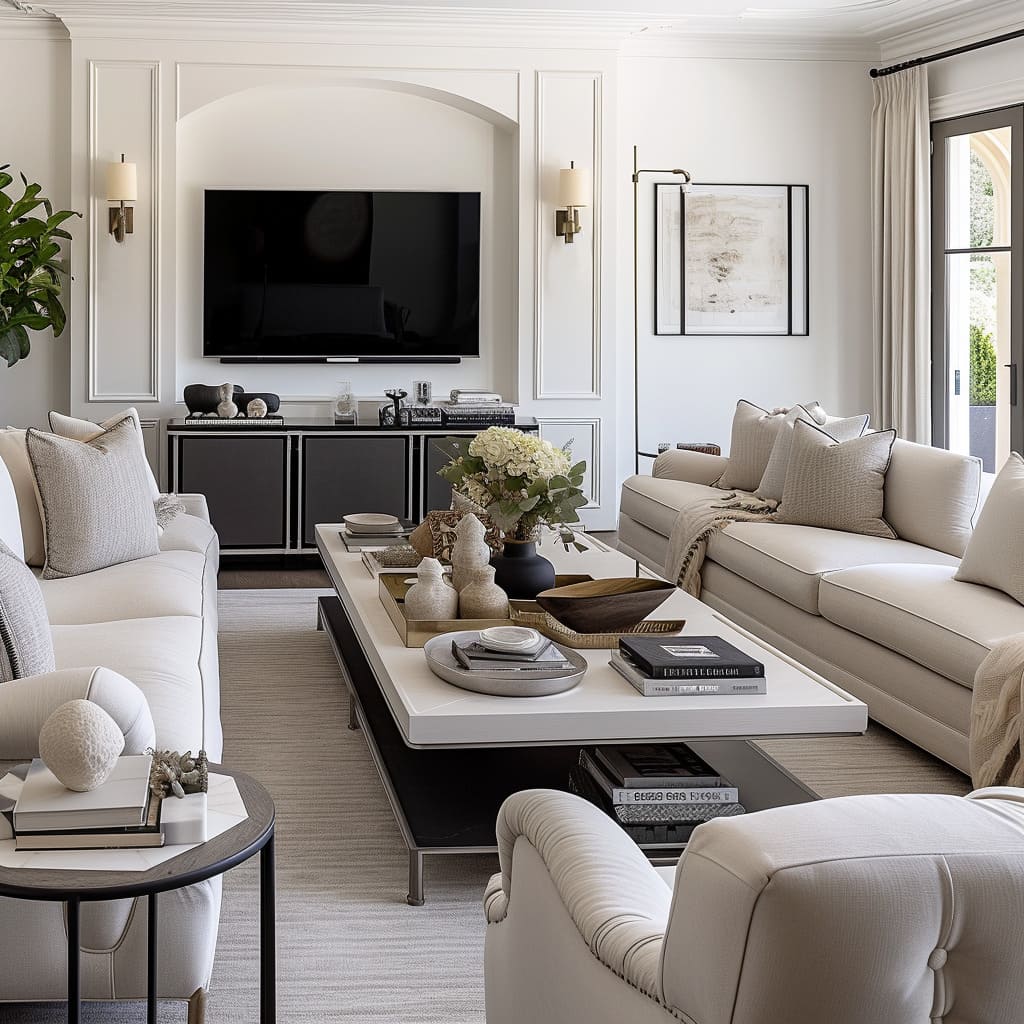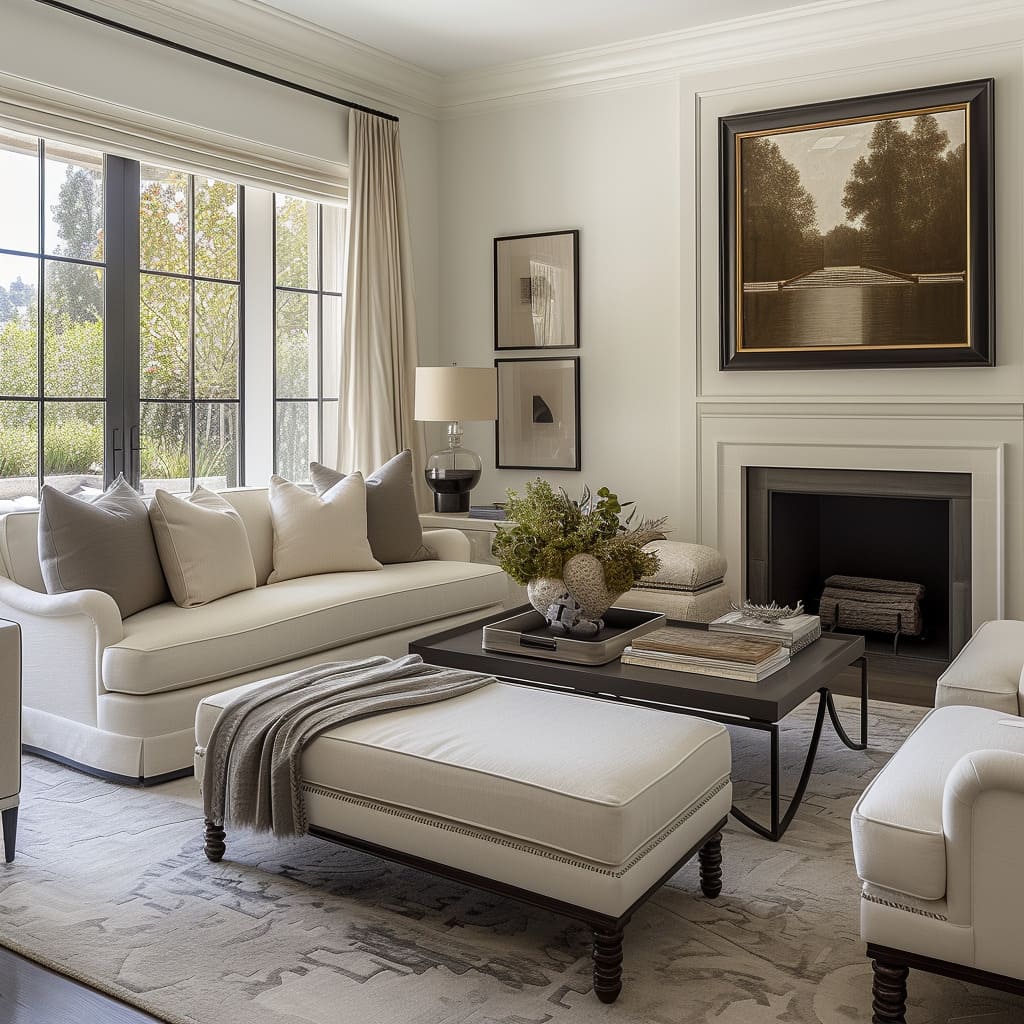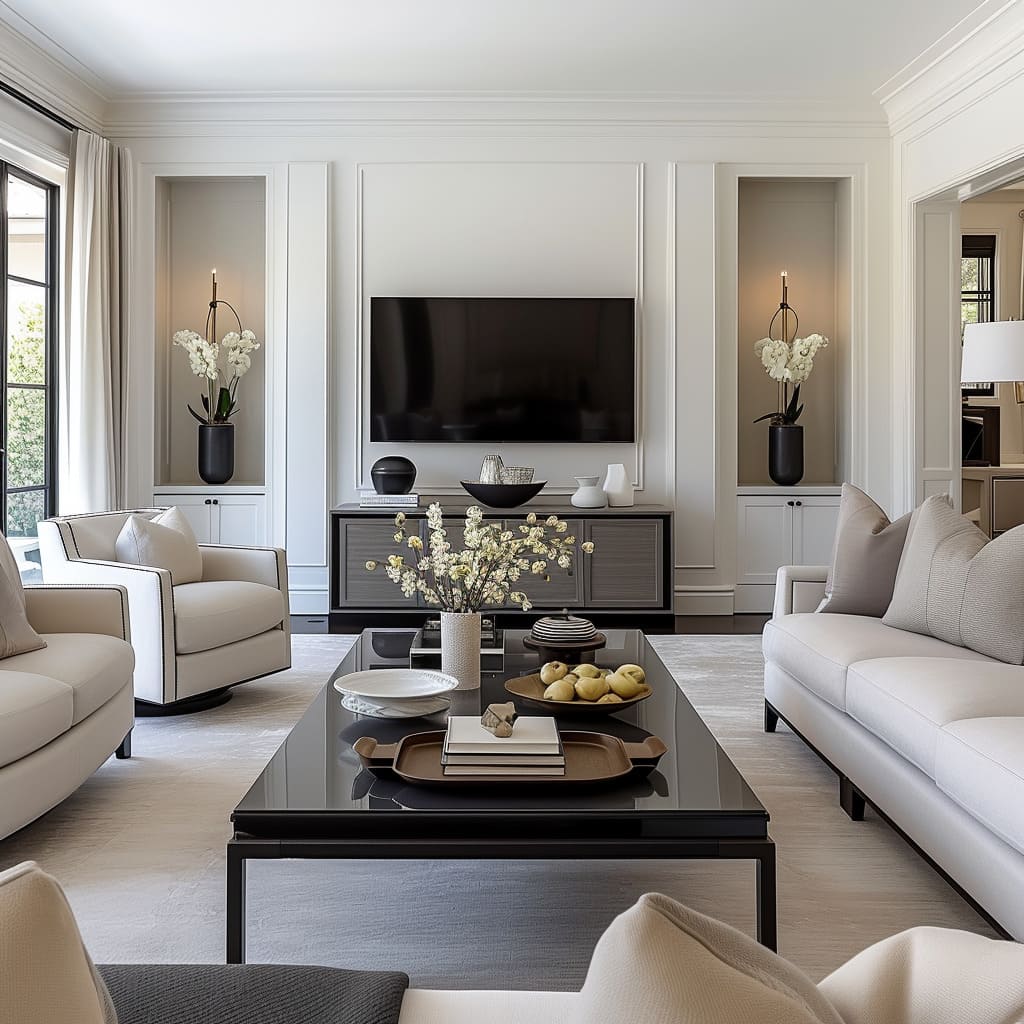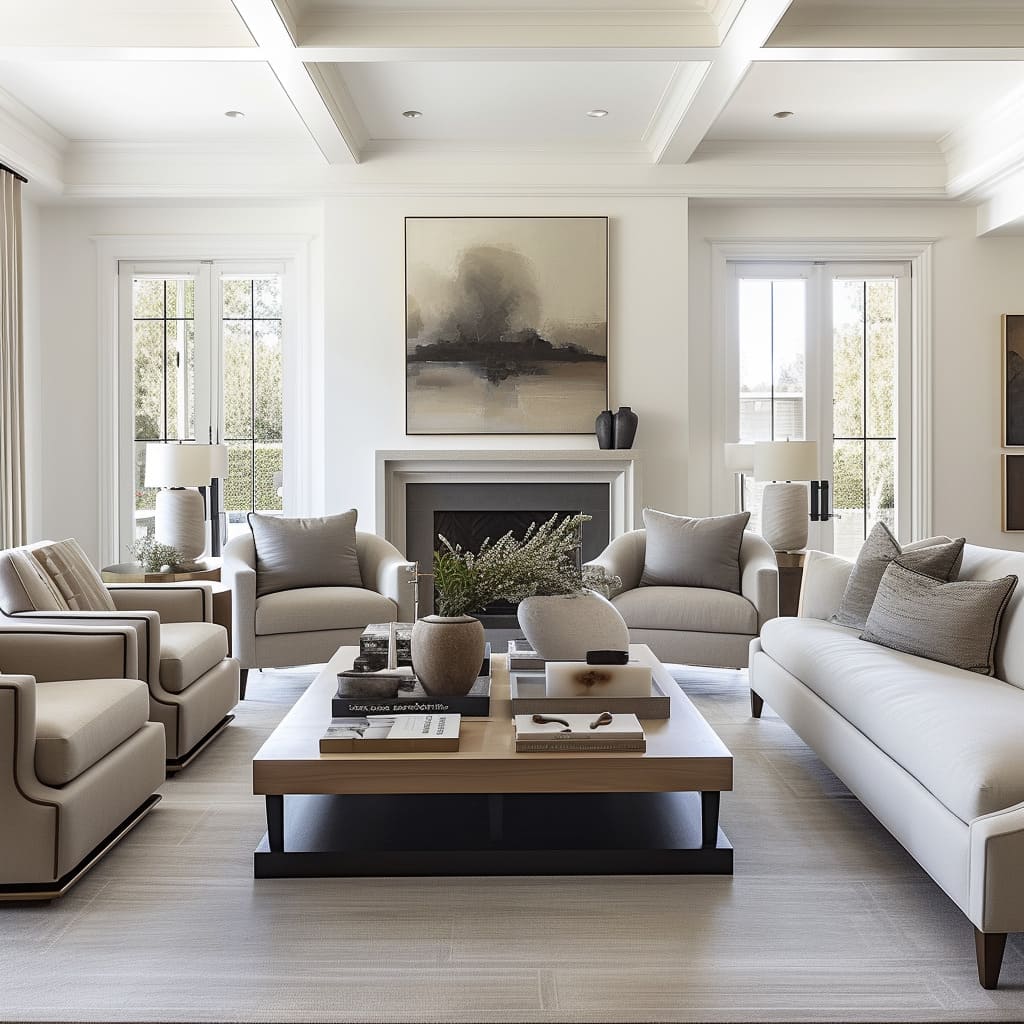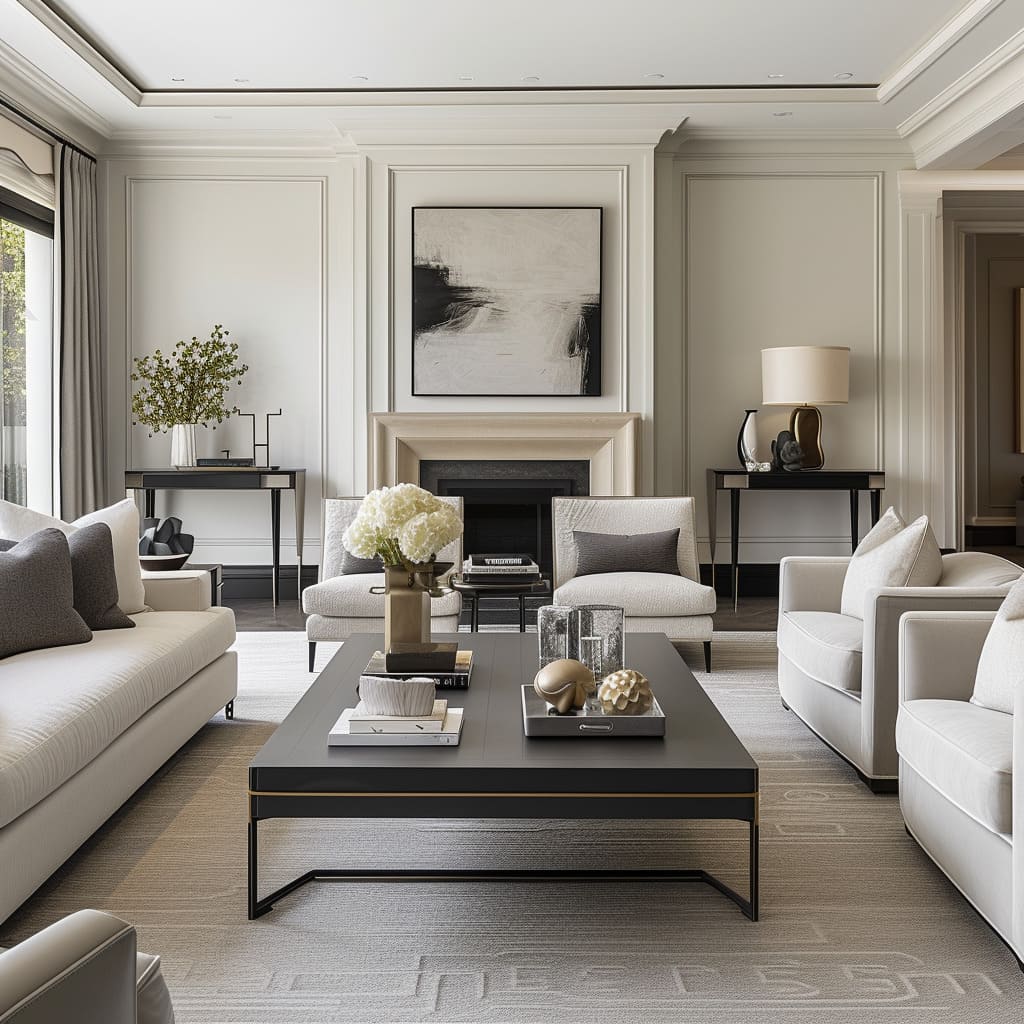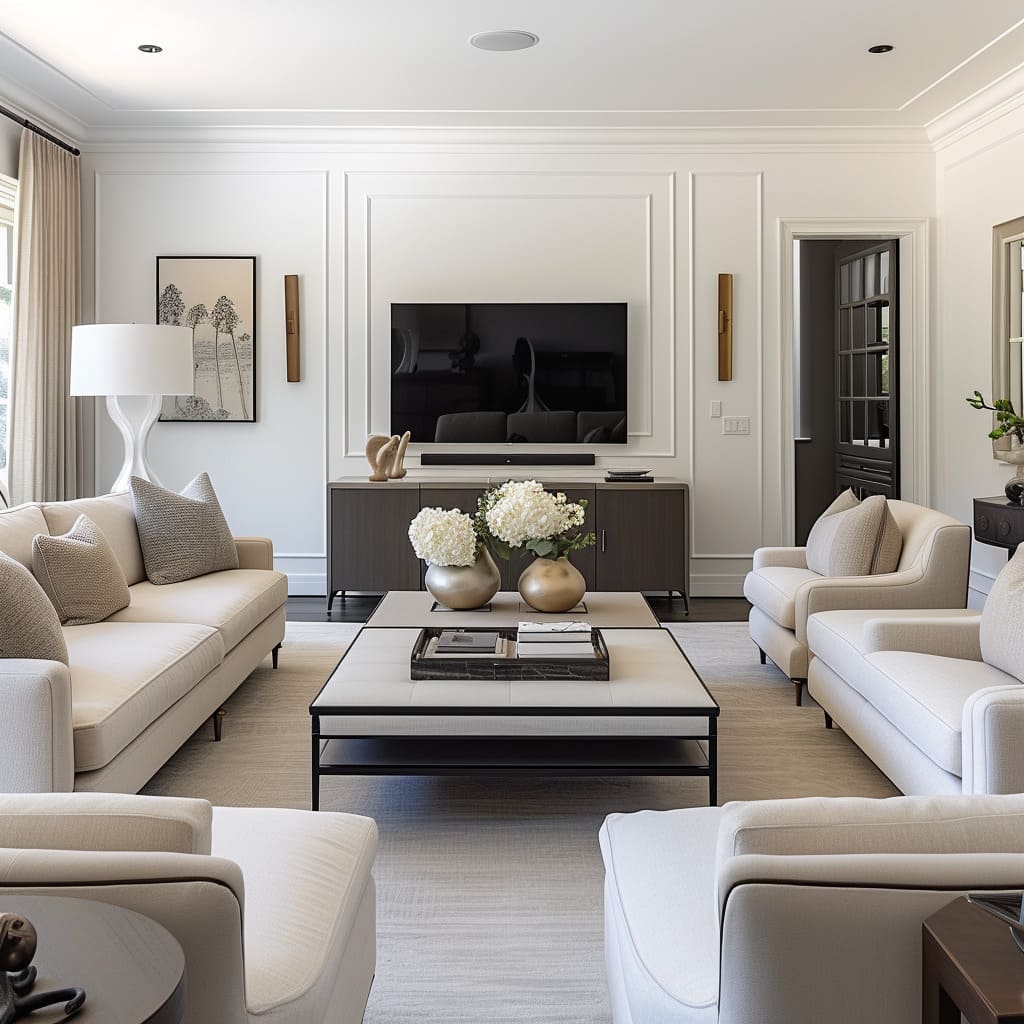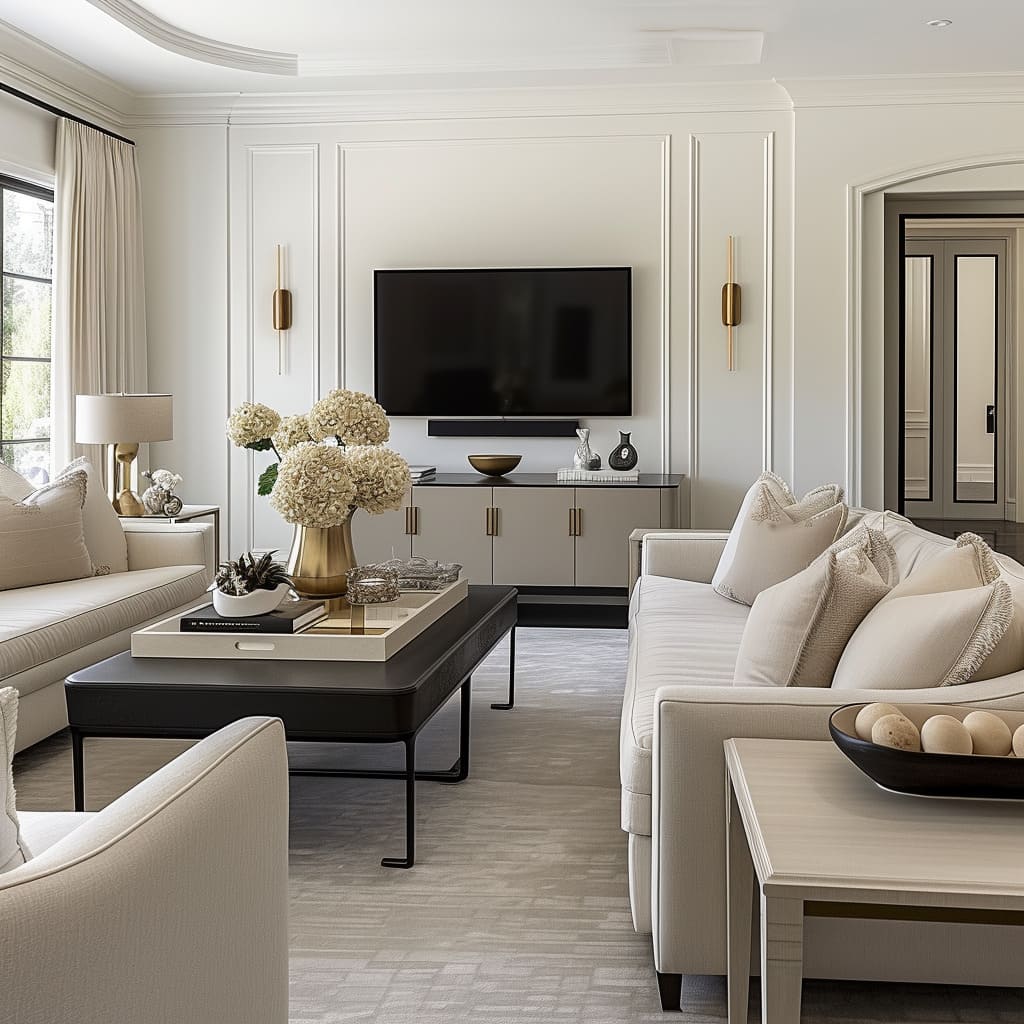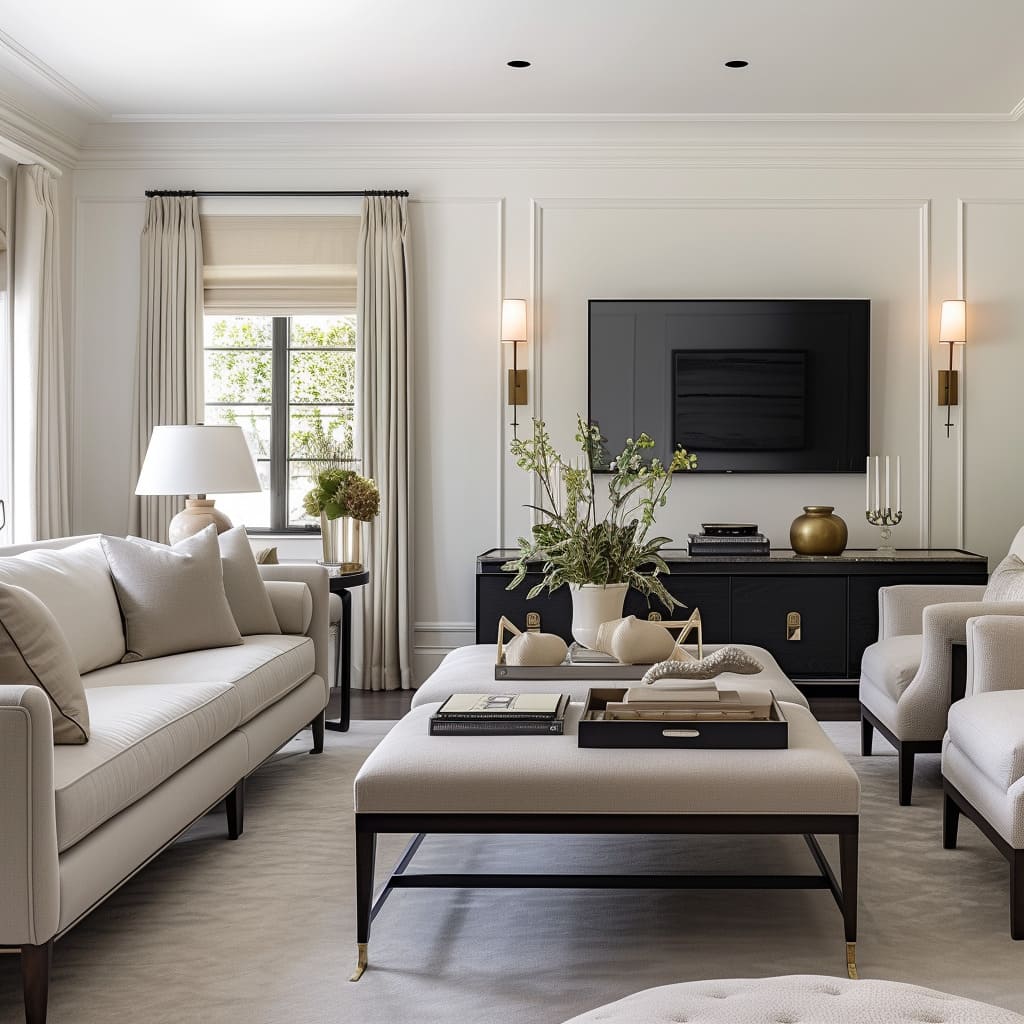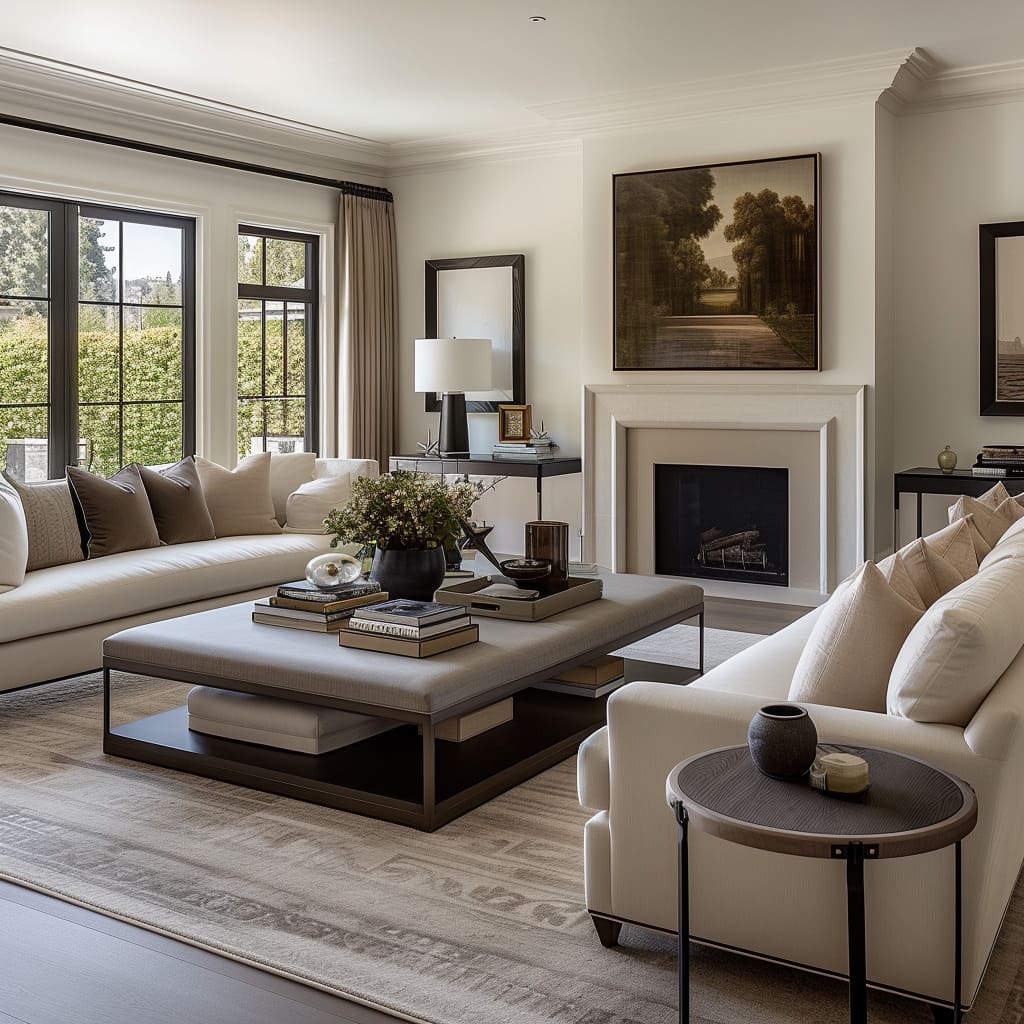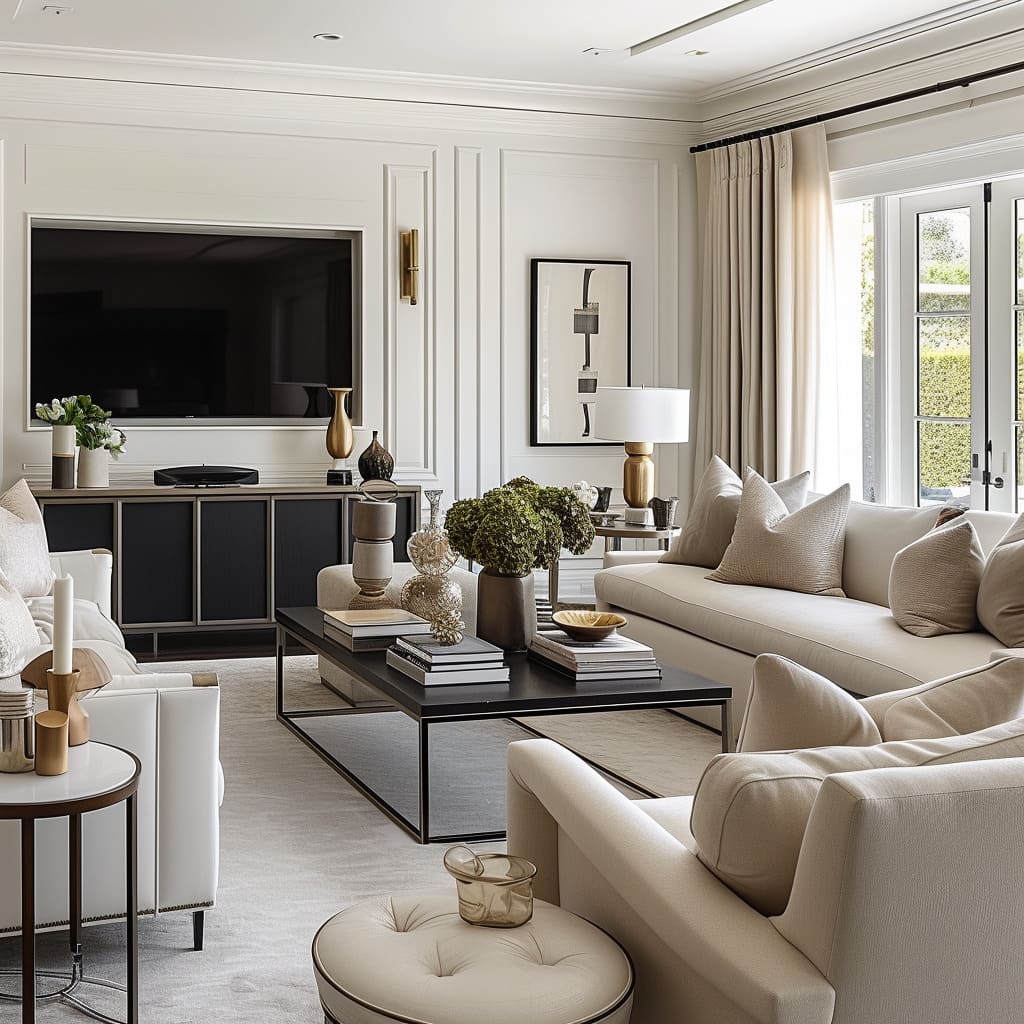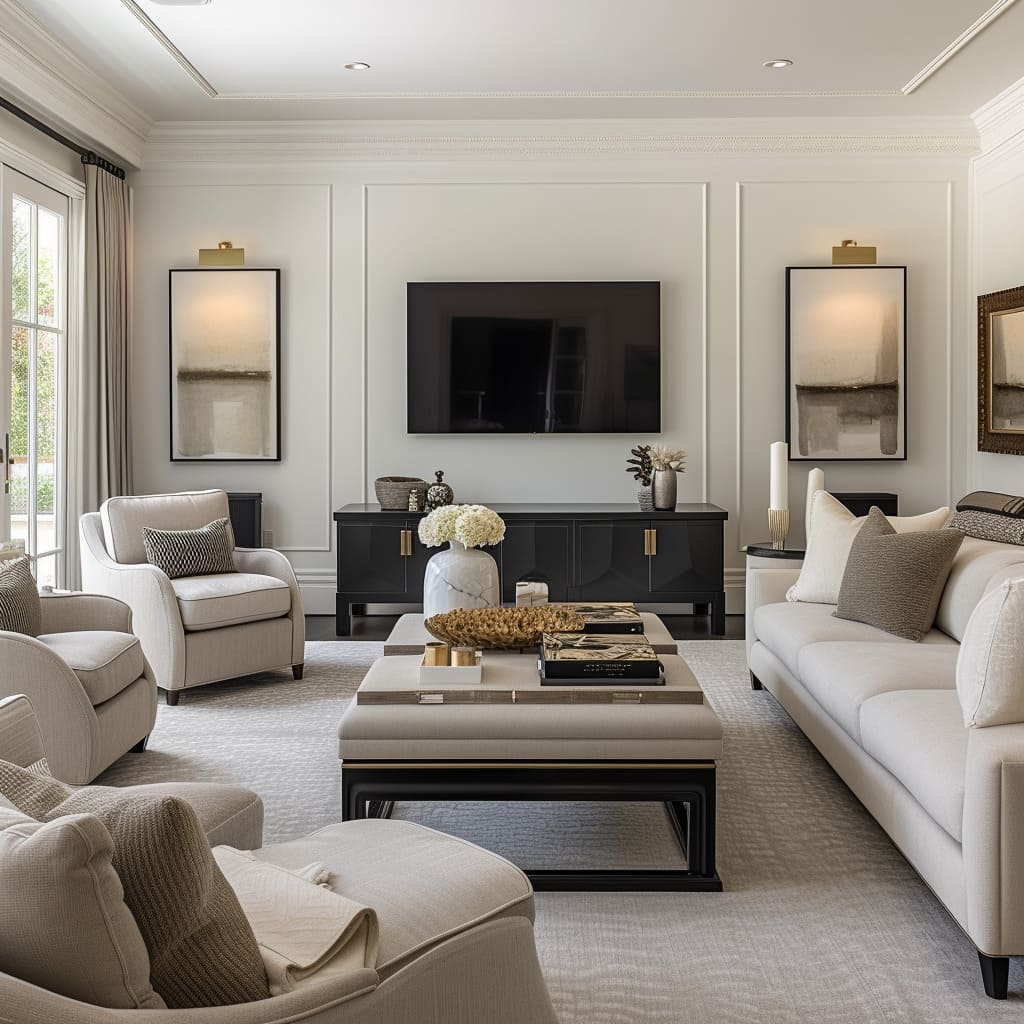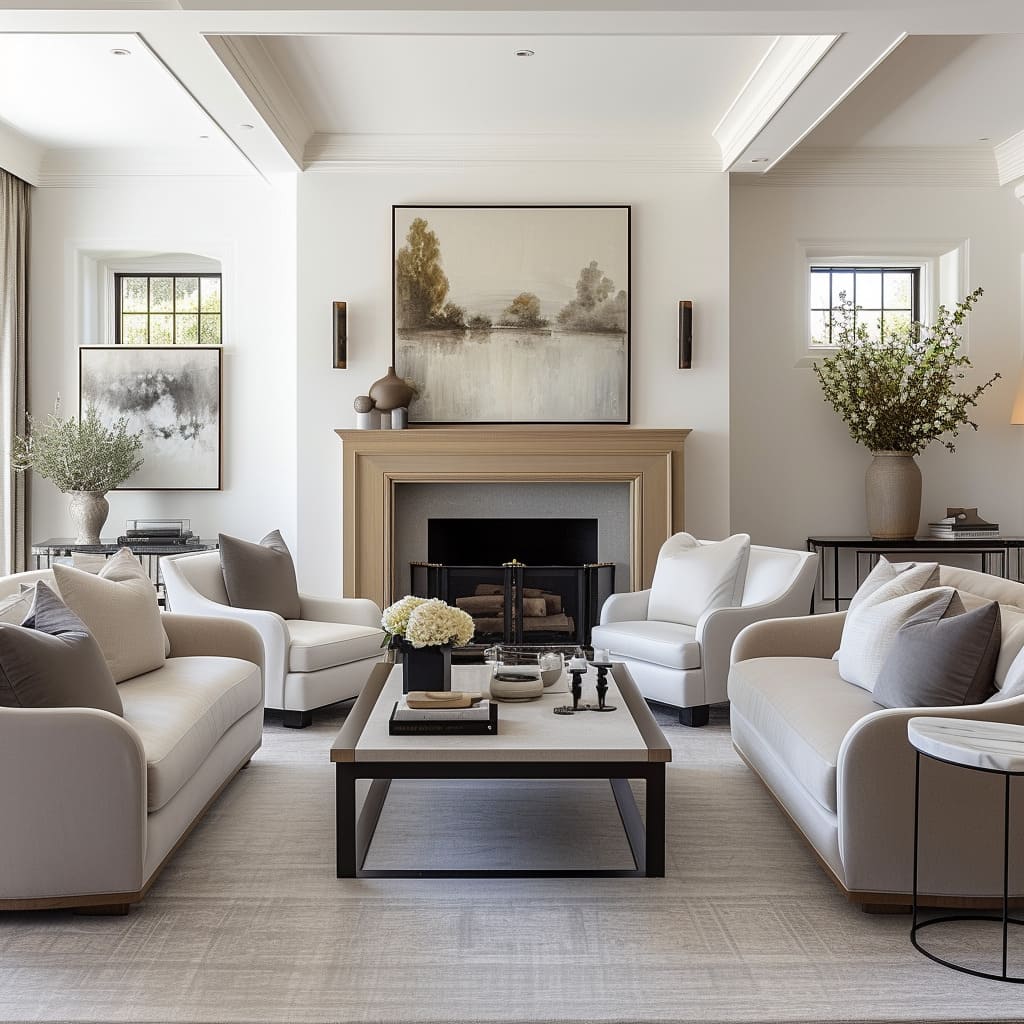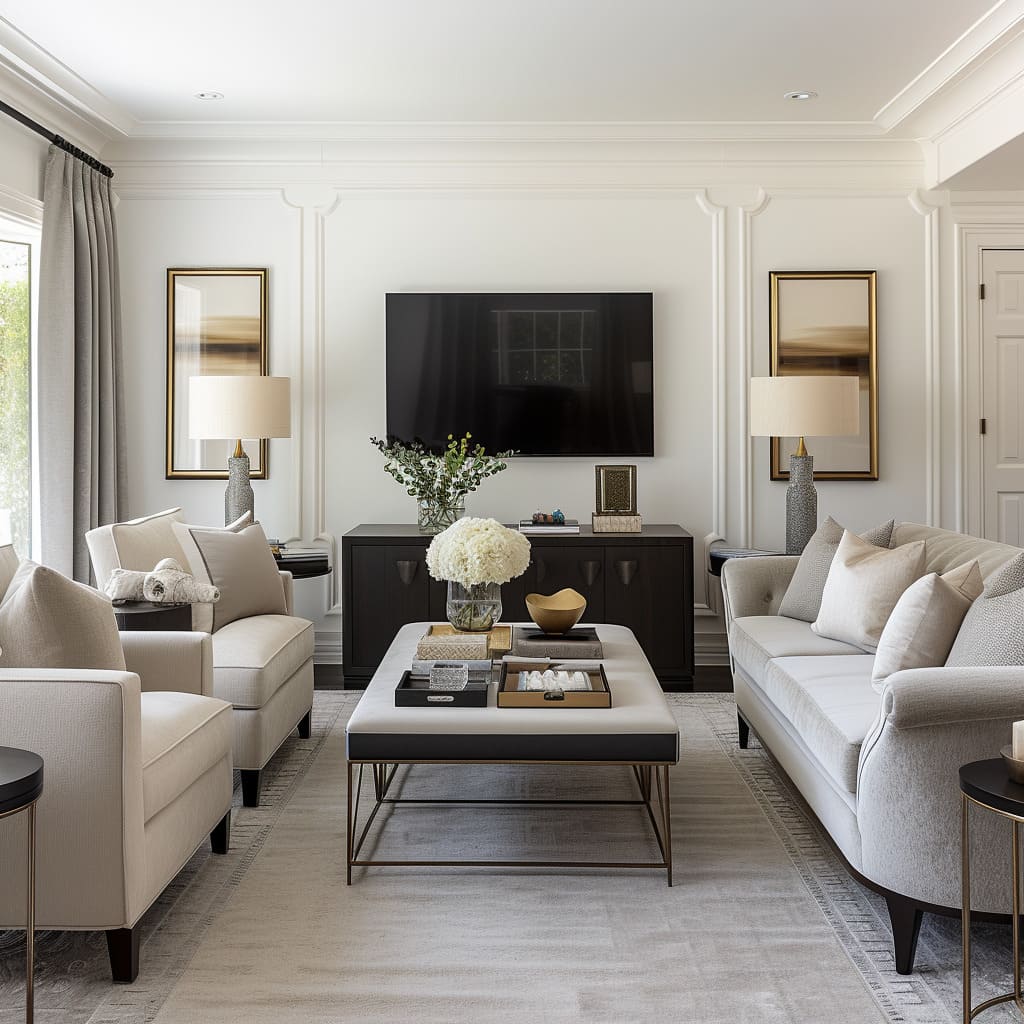Transitional interior design strikes a harmonious balance between the timeless elegance of traditional decor and the sleek simplicity of contemporary aesthetics. It’s a style that seamlessly marries the best of both worlds, creating spaces that are inviting, sophisticated, and adaptable.
In this article, we delve into the essence of Transitional design by exploring its eight defining features, as exemplified in the living rooms. From a neutral color palette that sets a serene tone to impactful artwork that adds a personal touch, each aspect of Transitional design contributes to the creation of living spaces that are not only stylish but also comfortable and thoughtfully composed.
Join us on this journey as we unravel the key characteristics that make Transitional interior design a timeless and versatile choice for homeowners seeking an atmosphere of effortless elegance.
Blend of Traditional and Modern Elements
A hallmark of Transitional style is the mixing of modern materials, like metal and glass, with plush traditional furniture. The living rooms showcase this blend beautifully.
For instance, the sleek lines of metal-framed coffee tables sit atop traditional area rugs, offering a subtle yet striking contrast. Modern sculptures and abstract art pieces adorn the room, yet they are flanked by traditional elements like upholstered wingback chairs and timeless fireplace mantles.
The juxtaposition is seamless, with each piece carefully chosen to complement the other despite their different origins.
The integration of such elements within a room requires a thoughtful approach to balance. The modern art pieces above classic fireplaces serve as a visual bridge between the traditional architecture and the contemporary furnishings.
Similarly, the contemporary coffee tables paired with more classic sofas echo the design philosophy of combining comfort with clean lines. This balance is not accidental; it is a deliberate choice that speaks to the sophistication of Transitional design.
In adding more details, one can observe that the modern elements are often in darker tones or sleek finishes, which contrast with the lighter, textured fabrics of the traditional furniture. This creates a dynamic visual interest that draws the eye around the room.
Accessories are minimal but impactful, with items such as brass candlesticks and ceramic vases that complement both the modern and traditional components.
To realize this feature in your interior, consider the scale and proportion of your furnishings. A modern glass-top table can be paired with a more ornate, traditionally styled sofa if they share similar lines and proportions.
When selecting artwork, choose pieces that speak to you personally but remember to consider frames that can bridge styles—perhaps a traditional painting in a sleek, modern frame, or vice versa. By doing so, you create a dialogue between the eras that each piece represents, allowing them to coexist harmoniously within the space.
Textural Variety
Transitional design’s reliance on a variety of textures to create visual interest and depth is clearly illustrated. The choice of fabrics is meticulous, with linen, velvet, and chenille offering a tactile experience that invites touch and comfort.
The plushness of the velvet contrasts with the natural, crisp feel of linen, while chenille adds a deep, soft texture that enhances the sense of luxury. Accessories are not just added for functionality but for their textural qualities as well—knitted throws beckon with their cozy allure, silk cushions shimmer with elegance, and textured pottery provides an earthy touch.
Looking closer at the interios, one can see how rugs with subtle patterns add depth to the flooring, while throw pillows with varied weaves introduce complexity. The accessories chosen, such as knitted throws and silk cushions, vary not only in texture but also in sheen and weave, contributing to a layered look that feels collected and personal.
Hard surfaces like polished wood floors, brushed metal light fixtures, and glass tabletops offer a sleek counterpoint to the softness of the fabrics, ensuring that the space feels balanced and not overly plush.
When incorporating these textural elements into your interior, consider the balance of textures to maintain a harmonious aesthetic. Mix smooth, sleek surfaces with soft, woven fabrics to create a pleasing contrast.
For instance, consider a soft chenille sofa adorned with silk and velvet pillows, complemented by a smooth leather ottoman and a glass coffee table.
To further develop this textural narrative in your own space, it’s important to pay attention to the interplay between light and texture. Soft fabrics like velvet and chenille can absorb light, offering a sense of warmth, while silk cushions can reflect light, adding a subtle glow to the room.
Similarly, a polished wood piece can add a warm sheen, while brushed metal can provide a cooler tone. Lastly, remember that texture can influence the mood of a space.
Soft, plush textures tend to create a welcoming and comfortable atmosphere, ideal for living rooms or bedrooms, while harder textures can add a sense of formality and sophistication, suitable for dining or office areas. By thoughtfully curating textures, you can craft a Transitional interior that is not only visually appealing but also emotionally resonant.
Minimalist Approach
The minimalist approach in Transitional design is clear in the deliberately chosen furniture and decor. Each item is purposeful and contributes to the room’s cohesive look.
This approach is where the spaces are free from clutter. The furniture is carefully spaced, ensuring that each piece has room to ‘breathe’, which accentuates the room’s architecture and the furniture’s design.
Notably, bookshelves are artfully arranged with a few select items rather than packed, allowing each piece to stand out and the backdrop to form part of the aesthetic.
In addition to the strategic placement of furniture, the minimalist approach is also about color discipline. The rooms shown stick to a restrained color palette, which amplifies the sense of order and space.
Subtle decorative elements like vases and books are chosen not just for their functionality or content, but for their ability to fit into the color story of the room. This attention to color and placement can make even simple objects look like curated compositions.
When it comes to implementing this minimalist approach in your own home, it’s important to be selective and intentional with your choices. Begin with a neutral base for large items of furniture and slowly add individual pieces that serve a purpose, either as a functional item or a statement piece that complements the overall design.
This could mean choosing a standout armchair that offers both comfort and visual appeal or a unique coffee table that acts as a centerpiece for the room.
The avoidance of over-decoration doesn’t mean spaces are left bare; instead, the decor is simplified to enhance the design’s impact. There are no extraneous items on coffee tables or mantels, yet the space feels complete.
The trick lies in choosing decor that has a strong presence—a sculptural vase, a bold piece of pottery, or a stack of beautifully bound books can be just as impactful as a collection of smaller items. To fully embrace the minimalist approach in Transitional design, focus on the craftsmanship and quality of pieces.
Opt for furniture with refined detailing, and choose decor that has a handcrafted feel. The understated elegance of high-quality materials like marble, solid wood, or hand-blown glass can create a sense of luxury without excess.
By investing in well-made items, you ensure that each piece stands the test of time both in style and functionality.
Clean Lines
The essence of clean lines in Transitional interiors is to strike a balance between sophistication and comfort. Sofas and seating options showcase straight, tailored profiles, with just enough detailing to draw interest without overwhelming the space.
The armchairs follow suit with neat outlines but are designed for comfort, as evidenced by the generous seating cushions. Occasional tables are geometric yet not imposing, with slim frames that enhance the feeling of spaciousness in the room.
These elements contribute to an overall aesthetic that is both modern and inviting.
One can note that the furniture is not blocky or cumbersome; instead, it has a lightness to it, with legs that lift the pieces off the floor, giving an airy feel to the interiors. This elevates the sense of elegance and ensures that the spaces do not become overwhelmed by heavy furniture.
The silhouettes are purposefully simple, which allows the quality of the materials and the craftsmanship to shine through.
When introducing clean lines into your interior, it is important to consider the scale and proportion of your pieces. A large, straight-lined sectional can serve as an anchor for your living space, while sleek, minimalist chairs can complement without cluttering.
Choose tables with slender legs and simple, unadorned surfaces for a look that is contemporary yet timeless. The strategic softening of these clean lines is evident in the use of plush cushions and throws that invite relaxation.
Rounded accents, such as spherical vases or curved floor lamps, introduce an element of softness that contrasts with the straight lines without detracting from the overall minimalist feel. This thoughtful combination ensures that the space remains welcoming and livable.
To implement this clean line strategy in your home, start with the larger pieces like sofas and dining tables, and ensure they have a streamlined design. Then, add in occasional furniture and accessories with more organic shapes to soften the look.
Pay attention to the legs and arms of furniture—a tapered leg, for instance, can offer a subtle curve that adds elegance without compromising the clean aesthetic. Remember that the goal is to create a space that feels cohesive, calm, and intentional, with each piece selected for both its form and function.
Neutral Color Palette
Transitional style’s neutral color palette sets the stage for a serene and timeless environment. We see that walls are often painted in soft shades of off-white, beige, or light grey, which serve as a perfect canvas for any accent colors brought in through accessories.
Floors are covered in similarly toned carpets or rugs, which help to reinforce the monochromatic color scheme. This choice of palette helps in diffusing natural light throughout the space, creating a warm and welcoming atmosphere.
To achieve this in your own space, focus on selecting a range of neutrals for large surfaces and add depth with a variety of textures.
Expanding further, the use of neutral colors in transitional style goes beyond just paint and flooring. It extends to the selection of furniture and decor.
You can notice that upholstered furniture often features fabrics in neutral tones like cream, taupe, or soft gray. This continuity of neutral hues throughout the room fosters a sense of cohesion and balance, allowing you to experiment with different styles of furniture and accessories without overwhelming the space.
Additionally, when striving to recreate this feature in your interior, consider the importance of natural materials. The interiors reveal a preference for wood elements in various shades, from light oak to dark walnut.
Incorporating wooden furniture or accents can enhance the warmth and timelessness of your transitional-style space. Consider wooden coffee tables, dining tables, or even wooden trim and molding to complement the neutral color palette.
To add a personal touch and visual interest, don’t forget to incorporate textures through textiles, such as throw pillows, curtains, and area rugs. The designs demonstrate how textures like linen, wool, and silk can bring depth and tactile appeal to your decor, making the space inviting and comfortable.
In conclusion, a neutral color palette in transitional style provides a versatile and soothing backdrop for your interior design. By paying attention to the details and considering the use of neutral tones, natural materials, and textures, you can successfully recreate this feature in your own home, achieving a serene and timeless ambiance.
Impactful Artwork
Artwork in a Transitional space serves as a conversation starter and a splash of personality. The interiors show how large canvases command attention without overwhelming the room, due to their strategic placement and often monochromatic or limited color schemes.
The art pieces are thoughtfully selected to complement the room’s color palette and design theme. To make a similar impact, consider the following details:
Expanding further, the placement of artwork in a transitional space is key. The interiors reveal that art pieces are often hung at eye level, creating a focal point that draws the gaze.
Consider grouping multiple artworks together, either in a gallery wall style or as a set, to create a visually striking arrangement. Varying the size and orientation of the frames can add an element of visual interest and sophistication.
You can also notice the use of large mirrors as part of the artwork ensemble. These mirrors not only reflect light and create a sense of spaciousness but also act as stunning decorative pieces.
Integrate mirrors strategically into your design to achieve a similar effect, especially in areas with limited natural light.
When selecting artwork, pay attention to the themes and motifs that resonate with your design vision. The living rooms showcase a variety of styles, from abstract and contemporary to classic and traditional.
To personalize your transitional space, choose art that speaks to your taste and complements the room’s overall aesthetic. Don’t be afraid to mix and match styles for a curated look.
To make your artwork truly impactful, consider proper lighting. Well-placed lighting fixtures, such as spotlights or wall sconces, can accentuate your art collection, highlighting its details and creating a captivating ambiance in the room.
In conclusion, impactful artwork is a key feature of transitional style that adds character and charm to your interior. By paying attention to placement, incorporating mirrors, selecting meaningful pieces, and adding appropriate lighting, you can recreate the striking effect, making your space a true conversation starter and a reflection of your personality.
Window Treatments
Window treatments in Transitional design are both functional and aesthetically pleasing. The designs showcase full-length curtains in luxurious fabrics that frame the windows without stealing the spotlight.
These treatments allow for privacy and light control while adding softness to the room. For your own space, choose window coverings that match the wall color for a cohesive look, or select a fabric that introduces texture and warmth.
Expanding further, the interiors reveal that Transitional window treatments often feature subtle patterns or textures that add depth to the design. Consider incorporating window coverings with delicate stripes, geometric patterns, or even subtle damask designs to elevate the overall visual appeal of your space.
These patterns can be found in curtains, drapes, or even Roman shades, depending on your preference.
Another aspect highlighted is the use of decorative hardware, such as curtain rods and finials. These details can play a crucial role in tying together the window treatments with the rest of the room’s decor.
Opt for hardware that complements the overall design theme, whether it’s sleek and contemporary or more traditional and ornate.
For those seeking a more minimalist approach, consider the use of sheer curtains. The living rooms demonstrate how sheer curtains can filter natural light beautifully, creating a soft and ethereal ambiance in the room.
Sheer curtains are an excellent choice for spaces where you want to maintain an open and airy feel.
Lastly, when selecting window treatments for your transitional-style interior, pay attention to the curtain length. The rooms showcase full-length curtains that gracefully pool on the floor.
This not only adds a touch of luxury but also visually elongates the room, making it feel more spacious and inviting.
In conclusion, window treatments in Transitional design go beyond mere functionality; they are a crucial element in creating a harmonious and visually appealing space. By incorporating subtle patterns, decorative hardware, sheer curtains, and selecting the appropriate curtain length, you can replicate the elegant and functional window treatments, enhancing the overall beauty and comfort of your interior.
In the world of interior design, Transitional style stands as a bridge between the classic charm of traditional interiors and the clean lines of contemporary aesthetics. As we’ve explored the key features of Transitional interior design, illuminated by the captivating living rooms, it’s clear that this style offers a unique blend of elegance, comfort, and adaptability.
From the soothing embrace of a neutral color palette to the artful fusion of traditional and modern elements, Transitional design creates spaces that are both serene and visually engaging. The use of textural variety and a minimalist approach further enhances the allure, making every room a sanctuary of sophistication.
Transitional design excels in its ability to maintain clean lines while infusing warmth through subtle curves, making furniture and decor choices both stylish and inviting. The inclusion of impactful artwork, carefully curated window treatments, and statement lighting fixtures adds personal touches and elevates the overall aesthetic.
In the heart of Transitional interiors, there’s an undeniable focus on comfort and class. Oversized, plush furnishings invite relaxation, while a deliberate approach to decorative accents ensures an uncluttered and harmonious environment.
This style’s adaptability empowers homeowners to infuse their personality into the design, all while maintaining the hallmark calm and cohesive atmosphere.
In essence, Transitional interior design is a testament to the art of balance. It effortlessly marries the timeless with the contemporary, the opulent with the understated, and the comfortable with the elegant.
As you embark on your own design journey, consider the elements of Transitional style to create spaces that resonate with effortless sophistication and charm, where classic meets modern in perfect harmony.




